
HWRK educational mag azine the online magazine for teachers JANUARY 2023 / ISSUE 24 / FREE HWRKMAGAZINE.CO.UK written by teachers for teachers Creative Writing Strategie S ALSO INSIDE: D E v ELO p IN g Exp E rt ISE t hr O ugh A C OAC h IN g Curr IC u L um Wh A t I’v E L EA r N t Fr O m rECO r DIN g 100 r E pODCAS t S Ar E tEAC h E r S IDE h u S t LES t h E N EW N O rm AL ? E FFEC t I v E C p D D ESI g N F O r tEAC h E r S Wh A t Ex AC t L y I S S C h OOL Cu L tur E ? t h E pOWE r O F S A y IN g “N O ”
Established in May 2006, we are one of the UK’s most dedicated and ambitious anti-bullying charities. Our award winning work is delivered across the UK and each year, through our work we provide education, training and support to thousands of people.
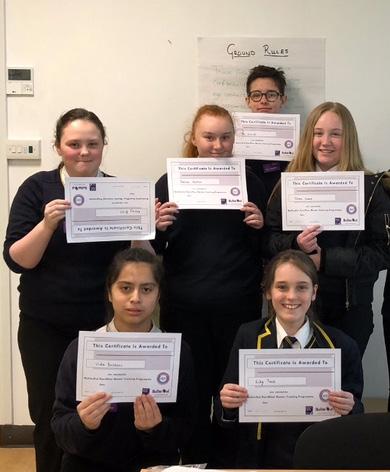
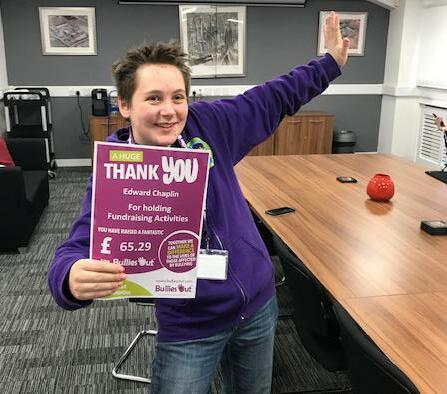
Through our innovative, interactive workshops and training programmes, we use our experience, energy and passion to focus on awareness, prevention, building empathy and positive peer relationships all of which are crucial in creating a nurturing environment in which young people and adults can thrive. Our Mission is to support individuals, schools, youth and community settings and the workplace through positive and innovative anti-bullying and well-being programmes and to empower individuals to achieve their full potential.
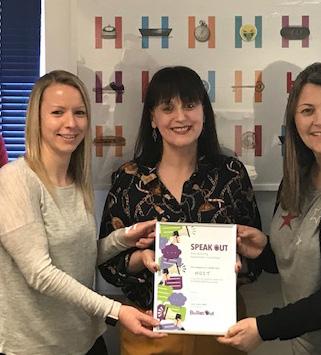
DIFFERENCE MAKING A INSPIRING CHANGE EMPOWERING YOUNG PEOPLE To find out more visit www.bulliesout.com | Email: mail@bulliesout.com
BELIEVE IN A WORLD THAT IS FREE FROM ALL
OF BULLYING BEHAVIOUR.
you would like to support us and help us to continue our lifechanging work, you can:
Volunteer with us
Fundraise for us
Make a donation
Join our Speak Out Campaign
Become a Corporate Partner
WE
TYPES
If
\
\
\
\
\
Exploring BEhaviour: unmEt nEEds, Wants or somEthing in BEtWEEn?
CONTENTS
EDITORIAL: THE POwER OF SAYING “NO” Saying “no” more often allows you to say “yes” when it matters most

FEATURES
6. EXPLORING BEHAvIOUR: UNMET NEEDS, wANTS OR SOMETHING IN BETwEEN?
Most behaviour is a form of communication, however, what the behaviour is actually communicating is debatable. But what should we do about it? asks Saira Saeed…
10. HOw TO RETURN TO wORk

A handy eight-step guide to making your return to work from illness work for you
PEDAGOGY
16. DESIGNING kNOwLEDGE ORGANISERS
How to create effective knowledge organisers with a strong rationale behind them
CURRICULUM
24. CREATIvE wRITING AND SELFREGULATION
How can we make a challenging task like creative writing more manageable? Jennifer Webb suggests some strategies to “shrink” it, to help students focus on what matters.
32. HOw I wOULD TEACH CREATIvE wRITING FOR AQA ENGLISH LANGUAGE PAPER 1
Andrew Atherton offers his advice on how to get students started with creative writing when they don’t know how to begin.
37. wHAT I’vE LEARNT FROM RECORDING 100 RE PODCASTS Louisa Smith is the host of The RE Podcast. In this article she shares some of the most interesting things she’s learnt…

40. TEACHING TIMES TABLES
A winning strategy for teaching times tables

46. wHAT EXACTLY IS SCHOOL CULTURE?
School culture can make or break a teacher. Shannen Doherty sets out what leaders needs to be mindful of when developing culture at their schools.

48. EFFECTIvE CPD DESIGN FOR TEACHERS
How can we design high-quality CPD for teachers? Amarbeer Singh Gill offers his suggestions on how to create CPD that is meaningful and effective.


53. DEvELOPING EXPERTISE THROUGH A COACHING CURRICULUM
Sam Gibbs offers suggestions on how to build an effective coaching curriculum to support teacher development.
LEADERSHIP EXPERIENCE
60. ARE TEACHER SIDE HUSTLES THE NEw NORMAL?
More and more teachers are taking on “side hustles” to make ends meet. But is it sustainable?

JANUARY 2023 // HWRK MAGAZINE // 03 HWRK MAG AZINE .co. UK // INSIDE THIS ISSUE
P 06 P53 P24 P40 P37 @hwrk_magazine
@hwrk_magazine 10 // HWRK MAGAZINE // Last August, precisely half way through eating a cheese sandwich, Tabitha had a stroke. This January, She has returned to the classroom for the first time. Cheese sandwiches may or may not be involved (they absolutely are). Here is her handy eight-step guide to making your return to work from illness work for you. By Tabitha McIntosh HOw TO RETuRN TO wORk 2023 // HWRK MAGAZINE // FEATURE Step One: Accept that you have made life more difficult for your colleagues That thought that keeps you up at night your absence did indeed make life more difficult for everyone else. Supply staff had to be found in very difficult season for be moved around or swapped and duties re-allocated; other people took on your pastoral responsibilities, your mountain of marking, your relentless data deadlines and your bad jokes. You left a hole in the department. had to be worked around and stepped over. Occasionally things fell into it, never to be seen again. And here’s why that’s okay: it’s testament to the fact that you and the job you do are necessary. Step Two: Become your own embarrassingly positive therapist There’s famously cringe-inducing scene in ‘Good Will Hunting’ in which a therapist played by Robin Williams chants ‘It’s not your fault’ at Matt Damon’s tortured, blue-collar genius face until a breakdown and breakthrough of some kind happens and everyone lives happily when say that may be the most Hopeful, positive, fatuously affirming, and, above all, achingly sincere. your fault. That hole in the department into which half your Year 11 folders planning your colleagues had to scramble to complete? Not your fault. for your absence? Not your fault. You’re not weak. You’re not failure. It wasn’t your fault. It’s not your fault. Sincerely. Try telling yourself in an American accent if your usual one is too embarrassed. Step Three: Stay out of your work emails while you’re recovering You’ve been signed off for reason. you’re not fit for physical work, you’re absolutely not fit for intradepartmental emails either. Following Step One means accepting that your absence has made Following Step Two means that you have embraced this and moved beyond the guilt. Looking at your department’s emails will undo all your hard work. It’s one thing to know that you left hole in the resulting chaos happen in real time. You can’t do anything about what the Y9s said to the supply teacher just before the end of Period 5. You are powerless in the even try. Remember: It’s not your fault. your problem. Step Four: Keep the school up to date if you No one expects you to have predictable and convenient progress towards returning to the workplace. But everyone appreciates timeline if one is available. Depending on the reason for your rehabilitation and occupational health professionals who can communicate with the school for you. None of them will send any information that you haven’t seen and agreed to in advance: your privacy absolutely crucial to their work. have found enormously helpful to hand communication over to objective and impartial professionals who aren’t burdened with silly things like anxiety and guilt and the need to make self-deprecating jokes about 1990s Matt Damon films. Step Five: Arrange a phased return to work Congratulations! Everyone wants you back: the school wants you back, the government wants you back, and you sure that you come back and stay back is with a well-thought-through planned return to work shaped by professional input. Your medical treatment will built into it. The school will arrange an occupational health assessment for their own purposes. Programmes like Access while you continue to rehabilitate. The most important thing here is that you don’t trip yourself up with insecurity and misplaced sense of obligation. role you played before you left, you are very likely to bounce back out. You aren’t completely better yet. You aren’t where you were before your absence. And that’s fine. Say it with me: it’s not your fault. Step Six: Arrange to visit the school before your official return date Bostonian an accent you have told yourself that it’s not your fault, the first return to the building is going to bring all that guilt, insecurity and anxiety screaming back to life. It absolutely helps to have gone in and said hello to colleagues. It is also absolutely, brain-meltingly, existentially terrifying. chose to do it at a time when knew the swarming with teenagers and when most of the teaching staff would be in lessons. It might help to have someone meet you at the entrance and walk with you. You may instead choose to stalk, slink or perambulate of your choice. Either way: get in there. It helps. Step Seven: Start shadowing the school day In the final weeks leading up to your return to the classroom, you must begin the Herculean process of adjusting your circadian rhythms, your appetite and your Start going to sleep and waking up at the same time you would for school. Experiment with going out and staying out for the length commute, build that into your experimental work day, but reward yourself with destination more relaxing than Friday afternoon classroom on windy day. One of the milder circles of hell for example. Step Eight: The most difficult step Accept yourself. I’ve been Type One diabetic for two decades and thought had concerned, my erratic blood glucose peaks and troughs were delightful eccentricity akin to coin collecting or weaving one’s own socks (if sock-weaving necessitated the occasional trip to A&E). But having had stroke feels different. It has peeled my thick skin back to the vulnerable nerve endings that are exposed when you first find out that your illness chronic. That your condition is life-limiting. That you are never going to get better. The final step the most difficult because needs you to let go of that idea of ‘better.’ This is you. This is me. And I’m going back exactly as am.
CURRICULUM 4. Promote the practice of ‘book dialogue’ Train students to have an ongoing conversation with their exercise book. This means that they are in the habit of writing notes and commentary in the margin of their exercise book as they go along. 5. Insist that the piece of writing isn’t the point – it’s all about the ongoing craft Highlight the idea that they aren’t working on a piece of writing, but themselves as writers The work in their book is their working memory externalised, not a shiny, polished, finished piece. Ensure that each shorter writing task pulls through to thread of skill development. These two steps are critical and inextricably linked to one another. A piece of student writing is NOT perfect, publisher-ready manuscript which should be put on pedestal. The process of writing itself is generative and messy. liken writing to painting or clay modelling students need to see that you have to make mess, make errors, cross out and reflect on your work at intervals in order to craft something effective. A beautiful tidy book is not the endgoal, here. An exercise book is: - A space to work out problems - A space to try out techniques - A space to jot down ideas, externalising them and extending your working memory capacity so that you can build and develop your thinking. - A space to draft, reflect and re-draft To get students thinking like this, we need to change their mindset about their writing. This is what did in this English Book dialogue: - After their first drafted piece of writing, asked students to highlight the sentence they were least happy with and write comment in the margin about why. - I them to do the same for two sentences AND word choice they were unsure about. - During the next draft, ask students to just make any notes about uncertainty or challenges they experience in the margin as they go. model this under the visualiser, and show them, for example, how might highlight margin to show that want to come back to it because I’m not sure it’s the right choice. - Over time, I built this into a consistent part of their writing – students didn’t need to be asked to do this by the end of the unit, because they were doing it automatically. Ongoing craft: Over the course of the unit, was aiming for students to develop one or two really strong pieces of writing. This might have become repetitive or static, had not been about writing short pieces and then tying things together and synthesising their shorter pieces. This is what mean… Writing task 1: A short, literal description of scene as depicted by a photograph they had brought Writing task 2: Taking and transforming it into gothic description by changing specific elements of lighting and temperature. Writing task 3: Looking at a model exposition (the opening ), and then reflecting task 2 and how it might be improved to create more compelling atmosphere. Writing task 4: Students looked at pathetic fallacy as technique, and wrote paragraph using pathetic fallacy. They then found way to combine this with their work from They reflected on things they should keep, things to discard and things they might want to introduce in order to make those two pieces of writing work together. This is just short example of how this might work from one piece to another in continuous thread. This is something which we sustained across the whole unit, so that students could develop ideas from one piece to the next, but also introduce new ideas and experiment with new things. Fundamentally, creative writing requires firm foundation of knowledge, paired with the mindset of someone with over their own work. By giving students excellent explicit instruction in areas of key knowledge, and demonstrating high level models and processes, we provide the base. But this knowledge alone is nothing. Students must take that knowledge and have the confidence to play with language, make choices, change those choices and see themselves as writers. It is so easy for writing instruction where the teacher models and students mimic. However, when we have an open dialogue about choice and self-regulation, our young people actually become writers.
It’s true to say there has been nothing short Career Framework (ECF), which provides teachers in their induction period with statutory entitlement to weekly coaching or mentoring, has contributed to this. Developing expertise through A CoAChing CurriCulum Sam Gibbs explores what is meant by coaching, which can mean different things to different people, while offering suggestions on how to build an effective coaching curriculum to support teacher development. We have seen the production of plethora of rising enthusiasm for instructional coaching. Many schools are keen to utilise its many benefits, to the point where it can sometimes seem like it is taking place in every school. But of course, teacher coaching is nothing the current bandwagon, therefore, we need – like with any promising approach in education to carefully consider the purpose and the implementation. LEADERSHIP dEvEloping ExpErtisE through a CoaChing CurriCulum CURRICULUM By Jon Bee Multiplication times tables are too important to be left to chance. A clear, systematic approach is needed across school in order to support all children to recall times tables facts, both quickly and reliably. Children need to be fluent with multiplication times tables in curriculum. Without fluency and quick recall of multiplication unconnected and confusing. Sounds of ‘I can’t do Maths’ may ring out around our classrooms. Leaving times tables to chance will curriculum. So how might we teach children multiplication facts so that and fluently and to recall them in order to access the curriculum? Enter: the counting stick. Counting sticks are not new to classrooms, but reimagining their The counting stick should be held in the middle to anchor the times tables facts (shown by an arrow in the image below). Jon Bee discusses the pros and cons of using counting sticks to teach multiplication times tables how i woulD teACh multipliCAtion times tAbles tEaChing timEs taBlEs By Louisa Smith idea what was doing, whether it would work and didn’t conceive that 2 years later would still be doing it, and that people would value it. All knew was that, after 20 years in the classroom, wanted my teaching day job. In short, The RE Podcast has changed my life. It has given me purpose, it’s improved my teaching, it’s reinvigorated my passion for education and RE, and it has connected me with so many humbled and privileged. As approach my 100th episode, am naturally reflecting on what has been created and what have learnt. Obviously have learnt how to do podcast, how to edit it and how to promote it! had to learn from scratch! But on personal note, have learnt that am better than people told me was. It feels like this is what was fears and challenges but it uses all my skills am natural communicator, am an extrovert, and am total geek. am also not a details person - I creating the podcast never causes religious Education unnecessarily high expectations, and don’t mind if it’s not perfect. Things just sort of fall together. am really good at time management and organisation but not in way that stifles creativity. past for not being tidy, but think this is key to my success if was too organised, would not be able happy to have an untidy house, am happy to interview someone when haven’t had time to research fully because have developed skills throughout my life to adapt when things don’t quite go to plan. Louisa Smith is the host of The RE Podcast. In this article she shares some of the most interesting things she’s learnt… whAt i’ve leArnt From reCorDing 100 re poDCAsts
i’vE lEarnt from rECording 100 rE podCasts LEADERSHIP senior leader berating staff for booking something the hall on the day he wanted leaders and saying they just don’t care about the job that much …the list could go on. This barely touches comments suggest these people should just put their head down and get on with because might be worse somewhere else outweigh the negative. But that doesn’t positive culture not good enough. No teacher should go to work worried about The negative impact of toxic culture Let’s look at positive culture and invested in, and who want to try things out because they want the best education for their pupils. Positive workplace cultures vision and purpose. Nobody feels unsure about the reaction they’ll get they suggest something new. Ultimately, the culture of school starts and the temperature the current culture in to play in ensuring the culture ticks along, but the leaders are responsible for setting the tone and working with any bad eggs on don’t think I’ll shut up about this until stop hearing wild stories of leaders on power trips who have cultivated negative deliberate choice. Finally, you do find yourself toxic environment, please know that there are
ExaCtly is sChool CulturE? P46
CrEativE Writing and sElf-rEgulation
What
What
CONTRIBUTORS
WRITTEN BY TEACHERS FOR TEACHERS
Saira Saeed
@SafeSENCOSaeed
Saira (better known as Miss Saeed) is an experienced Secondary School practitioner who has been teaching English for the last 17 years. She has also taught PSHE and RE for some of those years. As an accomplished DSL and SENCO, Saira specialises in all things Safeguarding and SEND.

Amarbeer Singh Gill

@SinghAmarbeerG
Amarbeer Singh Gill (or Singh as he’s more commonly known) is a teacher educator for Ambition Institute, former lead practitioner of secondary Maths, and author of Strengthening the Student Toolbox “In Action”. You can read more about his thinking on his blog: www.bit. ly/UnpackingEducation
Jennifer Webb
@FunkyPedagogy
Jennifer Webb is an English teacher, Assistant Principal for Teaching and Learning, and Research Lead at Trinity Academy Cathedral in Wakefield. She is the best-selling author of: How to Teach English Literature: Overcoming Cultural Poverty (2019), Teach Like a Writer (2020) and The Metacognition Handbook (2021). Her new book, Essential Grammar, co-authored with Marcello Giovanelli, will be published by Routledge in June 2023.
Andrew
Atherton
@__codexterous
Andrew Atherton is a Teacher of English as well as Director of Research in a secondary school in Berkshire. He regularly publishes blogs about English and English teaching at ‘Codexterous’ and you can follow him on Twitter @__codexterous


Louisa Smith
@TheREPodcast1
Louisa is a secondary RE teacher with 21 years experience. Head of Life Skills, host of The RE Podcast, Teacher Hug Radio presenter, mum of two. Born in Brighton. Live in West Sussex. Teach in Surrey.



Jon Bee
@mrbeeteach
John Bee is a Primary Deputy Headteacher, Maths leader and Author, based in the North-East of England. He also runs MrBeeTeach.com, a resource website, which is aimed at helping primary-age students to develop their knolwedge and understanding of Maths.
Shannen Doherty
@MissSDoherty
Shannen is a Senior Leader and classroom teacher at a primary school in London. She loves all things Maths and enjoys getting nerdy about teaching and learning. Shannen’s debut book, 100 Ideas for Primary Teachers: Maths, came out in May 2021.
Tabitha McIntosh
@TabitaSurge
Tabitha McIntosh is an English teacher and KS5 subject leader at a Greater London comprehensive. She is also Type 1 diabetic, dangerously over-educated and terminally online



Adam Woodward
@adamjames317
Adam is the Director of Studies at Radnor House School, Sevenoaks. His passions within education lie in curriculum and teacher development as well as his own personal drive to becoming a better practitioner

@samlgibbs1
Sam Gibbs is Trust Lead for Curriculum and Development at The Greater Manchester Education Trust. She is an experienced English teacher, school leader, teacher educator and coach who has worked with schools across the country on teaching and learning, curriculum design and implementation, and instructional coaching. Sam is co-author of The Trouble With English and How to Address It: A Practical Guide to Designing and Delivering a Concept-Led Curriculum (Routledge: 2022).
@sherish_o
Sherish Osman is a Lead Teacher (in charge of research and development), and English teacher at a school in West London, as well as a mother to two boys aged 2 and 5. She is the MTPT Family Friendly Lead at her school, working on making the school more family friendly with their policies for parents. Sherish is also the Design Associate for Litdrive, as well as the Educational Content Creator for Lantana Publishing.
hwrkMAG A zine.co.uk // M ee T T he T e AM
Sherish Osman
Sam Gibbs
Legal Disclaimer: While precautions have been made to ensure the accuracy of contents in this publication and digital brands neither the editors, publishers not its agents can accept responsibility for damages or injury which may arise therefrom. No part of any of the publication whether in print or digital may be reproduced, stored in a retrieval system or transmitted in any form or by any means without prior permission of the copyright owner.
HWRK MAGAZINE
LTD 48-52, Penny Lane, Liverpool, L18 1DG, UK E: enquiries@staffroommedia.co.uk T: 0151 294 6215
EDITOR Andy McHugh PUBLISHING DIRECTOR Alec Frederick Power DESIGNER Adam Blakemore MANAGING DIRECTORS G Gumbhir, Alec Frederick Power
PUBLISHED BY STAFFROOM MEDIA
thE PowEr of Saying “no”
Want something done?
Ask a busy person.
Being “busy” is something I’m known for and to some degree I’m proud of it. Saying “no” doesn’t come naturally to me. I’m not sure why. Perhaps it’s because I don’t want to miss out on the latest thing, or because I don’t want to disappoint someone who has asked for my help. But the problem is that over time it can lead to overwhelm and, crucially, opportunity-cost.
So, to counter this problem, when planning the goals for my department over the coming months, I’m keeping three questions in mind:
(1) what will I keep doing?
(2) what will I adapt?
(3) what will I stop doing?
You might have noticed that I don’t have “What should I start doing?” in my list of questions. This isn’t because it’s unimportant, it’s because it’s a highly problematic question. It’s risky, as “adding more” can take me away from the core priorities of my role, spreading my time too thinly. There is also an underlying and toxic tone of “you’re not doing enough” that accompanies the question and it’s one major reason why many teachers burn out and sadly leave the profession that they should thrive in. But these aren’t actually my primary concerns. What I’m much more
mindful of right now is that if I take on another “thing”, it leaves less time for me to do other “things” that are also valuable, or might even be more valuable.
Now, those of you with your “strategic leadership” hats on might do a quick analysis of which activities provide the most value to you, rank-ordering them and binning the least useful ones. It’s an effective way to begin tackling your needlessly-crippling workload and it frees up your capacity to pursue more worthwhile goals. It’s not enough though.
How can we make time for those activities that bring excellent value, but which we aren’t already aware of?
If I delete my least productive tasks and replace them with more productive ones, this increases my effectiveness, to a point. But If I’m then operating at capacity, I will miss opportunities to do things that I routinely turn down, due to being “too busy” - even if they would provide exceptional value.
How many times have you turned down going to an event, running a club, planning a trip, or organising a guest speaker, because you just don’t have the time? I’d wager you probably did have the time, but instead, it was filled with some other activities that, when you look back on them, weren’t as impactful, or even necessary at all. And we all suffer from this, from Teaching Assistant all the way up to Trust CEO.
This absence of “slack” in the system prevents staff from having adequate thinking time, opportunities to try out things that may or may not work (but are still worth trying) and, yes, to occasionally work with slightly less intensity, between the frequent bouts of ultra-busyness we’ve all unquestionably become accustomed to, so that we can keep “going again” with gusto.
In my opinion, if we’re going to be serious about dealing with the retention crisis in teaching, we need to address this personally, not just systemically. If we don’t individually get our own houses in order, where we can, then what hope do we have that others will too?
So, from this January, why not try saying “no” more often. It seems like a good way to get more done, sustainably and with a positive impact on your own well-being. It’s a start at least.
I’ll still be super-busy, but I’ll also be happy, doing “better” things, sticking to my core purpose more closely and with the capacity to do more when that unmissable opportunity presents itself.
Andy McHugh Editor | HWRK Magazine

Editorial:
JANUARY 2023 // HWRK MAGAZINE // 05 HWRK MAG AZINE .co. UK
Exploring BEhaviour: unmEt nEEds, Wants or somEthing in BEtWEEn?
By Saira Saeed
Having been on Twitter for a year, I have already lost count of the amount of Twitter debates I have read that centre on behaviour. I agree that most behaviour is a form of communication, however, what it is communicating is debatable. The term ‘unmet needs’ is widely used as a tool of criticism for numerous settings nationwide, which is simply unfair. If a student has unmet needs then it cannot and must not be assumed that this is deliberate on the part of the student’s setting. School leaders continue to face a plethora of battles in addition to the ongoing daily rigours of their jobs and sometimes they simply do not have the means, resources, facilities etc required to meet certain student needs.
Moreover, the Cost-of-Living Crisis is impacting schools, their students and their wider communities in drastic and heartbreaking ways. To add to the challenges, the process of either gaining the funds required to meet certain needs or find a more suitable setting for the student in question is time-consuming and emotionally draining for all involved.
This article highlights one particular facet of this challenge; not all poor behaviour in schools is due to a particular need being met/unmet by the school or its leaders. In fact, some of it is due to factors that aren’t fully in anyone’s control, hence can at best be managed and supported.

I intend to explore some of the things poor behaviour could potentially be communicating and then also suggest some strategies that could help. They are by no means ‘silver bullets’ for behaviour, but things to consider and/or try.
To note:
a.) This article is not an exhaustive list but provides ample food for thought.
b.) The case studies are based on true events but for GDPR purposes, key identifying factors have been concealed and (in some cases) events have been paraphrased rather than told verbatim.

@hwrk_magazine 06 // HWRK MAGAZINE // J AN u AR y 2023
Most behaviour is a form of communication, however, what the behaviour is actually communicating is debatable. But what should we do about it? asks Saira Saeed…
1. UnmeT need vs UnmeT WanT
This is arguably the most important factor to consider, as meeting the former usually has some statutory guidance and/or laws underlying them whereas this isn’t always the case for the latter. Notably, this does not mean that the latter is to be dismissed because some student wants are linked to their protected characteristics, thus making them as important as needs (think EDI and the Equality Act of 2010.)
Case study 1: A boy in KS4 started misbehaving as soon as he was moved to my class (lower ability set 4) and he had been moved as he was misbehaving too much in the class above mine (yes, there is lots wrong with this but let’s overlook that for now!) Initially, I tried many things but with no known needs and very little work (he barely wrote anything out of defiance) I was struggling to get him to behave. During a detention, I directly asked him what he wanted. “I want to be in set 2 Miss. I ain’t being rude but this ain’t my set.”
Whether right or wrong, I set him an exam question in my next lesson; in light of his answer corroborating with his claim I successfully utilised it to get him moved to set 2. He genuinely transformed into one of the best behaved and best attaining students in the set he was moved to. Was I meeting a need or a want? A bit of both, I think it would be fair to say.
Case study 2: A girl in KS3 began misbehaving for seemingly no reason and made a point of trying to be the class clown on any given occasion. This threw me, as this was completely out of character for her. I did not waste time in speaking to her and learnt that she was trying to impress a new boy who had joined our school and my class a few weeks earlier. When I asked the girl if her friend was correct, she nodded and apologised.
We then had a talk about many things including priorities and how to impress people without breaking school rules or behaving inappropriately. For those of you wondering, he had a girlfriend at his last school whom he was very loyal to so alas my young student’s efforts had been in vain! An unmet need? No. An unmet want? Absolutely.
2. medical needs

Medical needs are something that I personally feel aren’t given sufficient focus in staff CPD bar the statutory annual Asthma, Allergies, Epilepsy and Diabetes sessions delivered by a team of NHS nurses. This lack of focus serves to worsen medically triggered instances of behaviour, as staff won’t be equipped with the knowledge requisite to prevent these instances from occurring nor the skills to manage them when they do.
Case study 1: A severely asthmatic child in KS3 was on steroid tablets, which caused weight gain, thus impacting his self-esteem. This is turn made him extremely self-conscious, which manifested as sudden bouts of unprovoked anger.
Case study 2: A teen was misbehaving in a seemingly deliberately defiant manner. Upon liaising with her family, it was discovered that she had an eating disorder and was trying to curb her hunger pangs by drinking multiple cans of energy drinks a day, and was also seeking energy bursts via bags of sweets. These were making her extremely hyperactive, thus disruptive in lessons.
In both these case studies, the solution wasn’t straightforward nor quick, but in collaboration with the SENDCO who was also the medical lead, a comprehensive IHCP (Individual Healthcare Plan) was put together to help staff (and the student) manage their behaviour.
3. send
Undiagnosed SEND is a complex area, as it can take a very long time to identify it and subsequently seek out and provide additional support, resources etc that the student needs. In the interim, if staff aren’t aware of what to look for etc, students will suffer (the students displaying poor behaviour and their peers in their lessons.)
Case study 1: A student in KS3 had undiagnosed Speech and Language difficulties, which created multiple barriers to his learning; limited vocabulary, which in turn hindered his ability to articulate what he wanted to say, forgetting what he meant to say and lacking (at times) intelligibility so he knew what he was saying but few others understood. His understandable
frustrations manifested themselves in many ways ranging from low-level disruption to outright refusal to do anything.
This took a lot of work to address, as the student needed substantial external support amongst other things (securing speech and language therapy is no mean feat!) He was also an EAL learner, which added to the challenges faced by him (and my colleagues and I) when trying to develop his communication and interaction skills.
Case study 2: A KS5 student quickly became notorious; rude, running out of lessons, refusing to work, distracting peers amongst other similar behaviours. Upon liaising with her family and other teachers, I learned (in my capacity as SENCO) that they had asked for help from the setting for many years prior to my joining it, as they believed she was Autistic and because they had not been helped, they (and their daughter) had given up on the system.
This case was multi-faceted as it was a result of multiple issues; unidentified SEND, broken down relationships between a family, student and the setting, a student who’s behaviour was out of control and a set of staff who wanted to teach her (she was very bright) but didn’t want her in their lessons, as she was hindering the progress of her peers.
A number of actions took place collaboratively over a period of time but eventually a reduced timetable was put in place for her before she successfully completed her KS5 journey. Sadly, her needs weren’t fully met before she left but the processes for obtaining an Autism diagnosis had been initiated so that they could be in the next stage of her life. This wasn’t an ideal outcome but the best that could be done in light of the legacy attached to it.
4. safegUarding
Safeguarding is a complex area riddled with an increasing number of barriers to detecting potential abuse, neglect and the like. A clear and consistent set of processes including an effective system of information-sharing is required (as per the ‘Keeping Children Safe in Education’ 2022 DfE guidance) in order to ensure that no child ‘slips through the net’ through being misidentified as simply a disruptive student.
HWRK MAG AZINE .co.u K JAN u AR y 2023 // HWRK MAGAZINE // 07 FEATURE
Case study 1: A student in KS4 was seemingly always disengaged in my lessons and rarely handing in homework (with the repeated excuse that she ‘forgot’ or ‘was busy.’) Upon investigation, my colleagues and I learned that she was in fact a young carer with a very sick mother (single parent) and younger siblings whom she was practically mothering. The support she required was beyond my classroom but safe to say, I adapted my approaches when teaching her (leniency with homework deadlines, checking on her regularly in my lessons when circulating my class and so on.)
Case study 2: A KS3 student misbehaved for me repeatedly: defiance, distracting others, being completely disengaged in every lesson etc. I learned, at a Parents’ Evening meeting with his father (who was a single parent) that the student had been abused by his mother for the first half of his life and I – unfortunately – looked VERY similar to his mother. That was it.
The student and I had a very long meeting with his father (the DSL was involved too) but he was eventually removed from my class because he continued to disrupt the learning of the rest of my class and my colleagues and I were also worried that him seeing his mother’s lookalike might be triggering for him (upon reflection, it probably was.) Not everyone will agree with the outcome of this case study but sometimes, the only feasible strategy is what happened with this student.
5. cUlTUral impacT
I could give umpteen case studies here. For instance, in many cultures (especially South East Asian) it is deemed exceptionally rude to make eye contact with an elder who is reprimanding you. It is also no secret that a child being identified as SEND is stigmatised in a number of cultures, hence some families may actively hinder settings from identifying their children as SEND learners and seeking out external support for them. In light of this, I would highly recommend doing your research; reach out to friends, colleagues and community leaders (you could even politely/ sensitively ask questions on social media platforms like Twitter) to learn more about the cultural communities your students are a part of.
suggested strategies:
1. Do not be afraid to ask for help; it is NEVER a sign of weakness/being an incompetent practitioner. I have been teaching for over 17 years and I will still
happily seek out strategies/advice if one of my colleagues has better control of a certain class than I do! Additionally, do not worry if you feel you are the only member of staff struggling with a certain student/class and/or asking for help. I can almost guarantee that you won’t be the only one experiencing this; it is more likely that you are the only staff member seeking help for it.
2. NEVER, EVER take poor behaviour personally. It is upsetting, may make you cry/angry etc (and that is completely valid) but you do not get paid to take it home with you nor to waste energy harbouring ill feelings towards anyone. Moreover, the student/s in question may not even give it a second thought after they have left the school gates, so why should you? Lastly, as covered in this article, the poor behaviour may have been a result of factors that have no malice attached to them at all and may even be a cry for help.
3. This next point feels like a case of grandma and sucking eggs but if you find yourself getting increasingly agitated that student x has an attitude problem, or an issue with teachers of a certain gender, or is just rude because they won’t look at you when being reprimanded then take a step back, breathe and inquire why (this may need to be done later and not at the time of the poor behaviour occurring.)
4. If the poor behaviour is impacting your lesson to the extent where it is stopping
you teach then for that instance, remove the student but do follow it up later. Every school I have ever worked in had a faculty buddy system of some sort whereby colleagues could send a student to a colleague’s classroom as part of a de-escalation process.
5. Information seeking is absolutely paramount and where appropriate and possible, converse with the student directly but if not then do liaise with your HoD, SENCO, DSL, etc as required. Context can be a real eyeopener!
6. Don’t be afraid to reprimand, as required. Yes, a number of the case studies above highlight that some poor behaviour isn’t deliberate but that doesn’t mean you don’t consistently follow your setting’s behaviour policies.
One of the best behaviour policies I have ever seen in a setting was unbelievably simple (yet still humane) but it worked because all staff were empowered and supported in applying it consistently and fairly in their lessons (as well as during duty at unstructured times.)
7. Establish good relationships with parents; they are a knowledgeable and powerful ally! Some of the trickiest students I have ever managed to successfully deal with had parents who supported me and reiterated my expectations at home.
@hwrk_magazine 08 // HWRK MAGAZINE // J AN u AR y 2023
Key consideration point: HQT (the concept formally known as QfT.)
As tempting as it is to list a set of strategies that will solve all behaviour management issues (eg doing X for learners with SEND or doing Y for students who have tough home lives etc), there is no simple quick fix.
A culture is needed where all of the areas listed above are taken into consideration when planning the intent, implementation and impact of the curriculum.
Acknowledging SEND and Safeguarding in tokenistic CPD sessions for staff, having sporadic curriculum drop-down days for students or inviting parents to tick-box coffee mornings will not suffice. These areas of education need to be threaded through the culture of any given setting in order for that setting’s curriculum to truly to be inclusive.
truly High-Quality Teaching; confident practitioners who feel valued and trusted to deliver a meaningful curriculum in a way that improves the learning experiences for all learners (not just SEND for example.) This in turn will make behaviour easier to manage, as there will be fewer opportunities for students to misbehave and when they do, staff will have ample knowledge and a broad range of strategies they can utilise to manage it.

Admittedly, this is easier said than done and requires investment from all involved (teaching staff, support staff, SLT, students and their families) but it can be done. Yes, the status quo has added a plethora of challenges (budgeting and staff retention to name but two) but that does not mean all hope is to be lost. In fact, what Ofsted are looking for is inclusivity and safety for all, which is needed now more than ever before:
Moreover, staff then need to be given adequate CPD to empower them to deliver this inclusive curriculum via www.gov.uk/government/publications/education-inspection-framework/education-inspection-framework
end note
We can all agree that behaviour is complicated. Why? Humans are complicated, especially young ones who aren’t physically, emotionally and mentally developed, hence adequately equipped to deal with this gargantuan challenge we call ‘life.’ There are no quick fixes for every form of poor behaviour that you may encounter during your career in teaching. However, investigating and identifying underlying reasons for behaviour (even if it is a classroom crush!) will place any classroom practitioner in good stead to manage it as best possible without compromising the learning of others in your classrooms.
recommended reading
• Tom Bennett - ‘Running the Room: The Teacher’s Guide to Behaviour.’
• Paul Dix - ‘When the Adults Change, Everything Changes: Seismic shifts in school behaviour’
• Rob Potts - ‘Caring Teacher: How to make a positive difference in the classroom.’
• Andrew Hall - ‘Safeguarding Handbook.’
• Stephen Lane - ‘Beyond Wiping Noses: Building an informed approach to pastoral leadership in schools.’
• Maria O’Neill - ‘Proactive Pastoral Care’
• Samuel Strickland - ‘The Behaviour Manual: An Educator’s Guidebook’
• SAPHNA Eating Disorder Toolkit - https://saphna. co/homepage/toolkits/eating-disorder-toolkit/
• DfE Guidance:
- Safeguarding: https://www.gov.uk/government/ publications/keeping-children-safe-in-education--2 - Medical: https://www.gov.uk/government/publications/ supporting-pupils-at-school-with-medical-conditions--3
- Looked After Children: https://www.gov.uk/ government/publications/promoting-the-health-andwellbeing-of-looked-after-children--2
HWRK MAG AZINE .co.u K JAN u AR y 2023 // HWRK MAGAZINE // 09
How To ReTuRn To woRk
 By Tabitha McIntosh
By Tabitha McIntosh
Last August, precisely half way through eating a cheese sandwich, Tabitha had a stroke. This January, She has returned to the classroom for the first time. Cheese sandwiches may or may not be involved (they absolutely are). Here is her handy eight-step guide to making your return to work from illness work for you.

@hwrk_magazine 10 // HWRK MAGAZINE // J AN u AR y 2023
Step One: Accept that you have made life more difficult for your colleagues
That thought that keeps you up at night is correct. There’s no way around this: your absence did indeed make life more difficult for everyone else. Supply staff had to be found in a very difficult season for recruitment and budgets. Classes had to be moved around or swapped and duties re-allocated; other people took on your pastoral responsibilities, your mountain of marking, your relentless data deadlines and your bad jokes. You left a hole in the department. It had to be worked around and stepped over. Occasionally things fell into it, never to be seen again. And here’s why that’s okay: it’s a testament to the fact that you and the job you do are necessary.
Step Two: Become your own embarrassingly positive therapist
There’s a famously cringe-inducing scene in ‘Good Will Hunting’ in which a therapist played by Robin Williams chants ‘It’s not your fault’ at Matt Damon’s tortured, blue-collar genius face until a breakdown and a breakthrough of some kind happens and everyone lives happily ever after. I’m speaking as an American when I say that it may be the most American scene ever committed to film. Hopeful, positive, fatuously affirming, and, above all, achingly sincere.
You need some of that. Because it’s not your fault. That hole in the department into which half your Year 11 folders have disappeared? Not your fault. The planning your colleagues had to scramble to complete? Not your fault. The reason for your absence? Not your fault. You’re not weak. You’re not a failure. It wasn’t your fault. It’s not your fault. Sincerely. Try telling yourself in an American accent if your usual one is too embarrassed.
Step Three: Stay out of your work emails while you’re recovering
You’ve been signed off for a reason. If you’re not fit for physical work, you’re absolutely not fit for intradepartmental emails either. Following Step One means accepting that your absence has made life more challenging for your colleagues. Following Step Two means that you have

embraced this and moved beyond the guilt. Looking at your department’s emails will undo all your hard work. It’s one thing to know that you left a hole in the department. It’s quite another to read the resulting chaos happen in real time. You can’t do anything about what the Y9s said to the supply teacher just before the end of Period 5. You are powerless in the face of Alex in Year 7s lost blazer. Don’t even try. Remember: It’s not your fault. Or your problem.
Step Four: Keep the school up to date if you can
No one expects you to have predictable and convenient progress towards returning to the workplace. But everyone appreciates a timeline if one is available. Depending on the reason for your absence, you will be seeing medical, rehabilitation and occupational health professionals who can communicate with the school for you. None of them will send any information that you haven’t seen and agreed to in advance: your privacy is absolutely crucial to their work. I have found it enormously helpful to hand communication over to objective and impartial professionals who aren’t burdened with silly things like anxiety and guilt and the need to make self-deprecating jokes about 1990s Matt Damon films.
Step Five: Arrange a phased return to work
Congratulations! Everyone wants you back: the school wants you back, the government wants you back, and you want to be back. The best way to make sure that you come back and stay back is with a well-thought-through planned return to work shaped by professional input. Your medical treatment will have occupational health assessment built into it. The school will arrange an occupational health assessment for their own purposes. Programmes like Access to Work can help with the commute while you continue to rehabilitate. The most important thing here is that you don’t trip yourself up with insecurity and a misplaced sense of obligation. If you try to step back completely into the role you played before you left, you are very likely to bounce back out. You aren’t completely better yet. You aren’t where you were before your absence. And that’s fine. Say it with me: it’s not your fault.
Step Six: Arrange to visit the school before your official return date
No matter how well, how often, or in how Bostonian an accent you have told yourself that it’s not your fault, the first return to the building is going to bring all that guilt, insecurity and anxiety screaming back to life. It absolutely helps to have gone in and said hello to colleagues. It is also absolutely, brain-meltingly, existentially terrifying. I chose to do it at a time when I knew the entrance and playgrounds wouldn’t be swarming with teenagers and when most of the teaching staff would be in lessons. It might help to have someone meet you at the entrance and walk with you. You may instead choose to stalk, slink or perambulate in the otherwise self-conscious manner of your choice. Either way: get in there. It helps.
Step Seven: Start shadowing the school day
In the final weeks leading up to your return to the classroom, you must begin the Herculean process of adjusting your circadian rhythms, your appetite and your bladder. You need to be re-institutionalised. Start going to sleep and waking up at the same time you would for school. Experiment with going out and staying out for the length of your usual school day. If you have a long commute, build that into your experimental work day, but reward yourself with a destination more relaxing than a Friday afternoon classroom on a windy day. One of the milder circles of hell for example.
Step Eight: The most difficult step
Accept yourself. I’ve been a Type One diabetic for two decades and thought I had stopped internalising ableism. As far as I was concerned, my erratic blood glucose peaks and troughs were a delightful eccentricity akin to coin collecting or weaving one’s own socks (if sock-weaving necessitated the occasional trip to A&E). But having had a stroke feels different. It has peeled my thick skin back to the vulnerable nerve endings that are exposed when you first find out that your temporary sickness is permanent. That your illness is chronic. That your condition is life-limiting. That you are never going to get better. The final step is the most difficult because it needs you to let go of that idea of ‘better.’ This is you. This is me. And I’m going back exactly as I am.
HWRK MAG AZINE .co.u K JAN u AR y 2023 // HWRK MAGAZINE // 11 FEATURE


PEDAGOGY
16. Designing Knowledge Organisers
How to create effective knowledge organisers with a strong rationale behind them

hwrkMAG A zine.co.uk JA nu A r Y 2023 // hwrk MAGA zine // 15
Designing Knowle D ge o rganisers
In my previous article, I spoke about the research behind memory and retaining information in relation to the implementation of knowledge organisers within the primary classroom. Below, I move on to explain how I have created knowledge organisers for my school and explain the rationale behind them and the “dos and don’ts”regarding their creation, ensuring that the benefits of them provide children with the perfect platform to retain and retrieve core knowledge around a subject.
By Adam Woodward

When implementing knowledge organisers as one form of retrieval practice in my school, it was important that teachers did not feel overwhelmed with their introduction. Therefore, I began this process with the Humanities subjects of History and Geography. They are the backbone to the primary curriculum, and this seemed like a logical place to start to be able to develop their implementation as a form of planning for curriculum progression across the school.
An important part of the process when creating knowledge organisers is that it begins and ends with the


class teacher. The first step that is taken is to ask class teachers what the key knowledge is that is included within their unit. These conversations occur in plenty of time before a unit begins and teachers provide this information, including any diagrams, maps or case studies that they want to include.

I spend the time creating these, making sure that links are made with prior units in conjunction with our Humanities lead. The class teacher, in liaison with our Humanities lead, then has the final say on the design for use in their classes.

The focus, during creation needs to revolve around the identification of key elements of knowledge required during a unit. These include (but are not restricted to) the inclusion of key dates, events, people and vocabulary. It is important to make links back to prior learning as part of a progressive curriculum model that builds upon the learning that has taken place in the unit, term or year before.
An example of this can be found in our History knowledge organisers where a ‘historical context’ section can be located. This section purposefully links back to periods of history previously covered within the curriculum.
@hwrk_magazine 16 // HWRK MAGAZINE // J AN u AR y 2023 PEDAGOGY
This example clearly shows children where this unit is located in relation to other units covered from the Celts through to the end of World War II. This unit is purposefully placed after our World War II unit for pupils to see the consequences of the war on the population.
In my school, I am responsible for the creation of these. It is a huge task initially, and I am fortunate to be in a position where I have time to be able to do this. I also understand that context is key and not all teachers have this benefit. However, I feel that it is important to ask the question ‘Why not give full autonomy to class teachers?’
There are three reasons why I have taken this task upon myself
1. Workload


Asking teachers to create their own knowledge organisers adds extra work on teachers who work

incredibly hard. With this added expectation, there is a chance that their creation could end up at the bottom of a ‘to do list’ pile and not created to a standard that children would benefit from, therefore making their use and application redundant. By investing the time that I have available in creating these, I can relieve this workload and support class teachers in implementing knowledge organisers, entwined with other forms of retrieval practice, into their curriculum with purpose.
2. ConsistenCy
I can make sure that there is clear progression across the school. One example of this is the use of dual coding within a knowledge organiser. Whenever a key word or vocabulary choice appears, the same icon is used across the school, so children are exposed to and reminded of the context of that word or period of history. If teachers
were responsible for the creation of their own knowledge organisers, there is the chance that different icons could be used in different organisers, thus not forming such a secure schema.
3. Quality Control
I have felt it important that each follows a similar structure, layout and organisation. For children, this breeds confidence as they know what to expect and recognise from knowledge organisers throughout their time in school.
However, as I stated previously, I am in a fortunate position of having the time to be able to create these. For other contexts, and to meet the reasons that I state above, the creation of a school-wide ‘working party’ could ensure that workload, consistency and quality control are all managed across the school.
J AN u AR y 2023 // HWRK MAGAZINE // 17 HWRK MAG AZINE .co.u K PEDAGOGY
Above is an example of a knowledge organiser for a Year 6 History unit. Most importantly is the historical context and where that period of history falls within other units that have been taught. For this example, Year 6 are going ‘back in time’ to a period in world history after covering elements of most of the other periods identified in this section.
Key vocabulary is clearly vital too. I have already mentioned the necessity of dual coding as a key part of the knowledge organisers that I create and this is visible here (as it is within the historical
context too). An example of the importance of dual coding is the icon used to demonstrate the word, ‘Invaders.’ This same image can be seen in other knowledge organisers containing the same word, including the use of it within our Anglo Saxons unit for Year 4. Key vocabulary choices are made to be included here but clearly not exhaustive. There isn’t enough room to include everything and, if I did, it would distract from other key areas of the unit.
With the timeline of key events, it is vital for most historical units to show the progression of a period of



history. Again, note the use of dual coding. Some icons can be identified in both the timeline and vocabulary and this is done purposefully for children to be able to identify links here.
Other important visuals including maps of key areas, and, in this case, an image of the Maya number system, add more visual detail to the unit and vital elements of knowledge for children to use and apply in their learning.
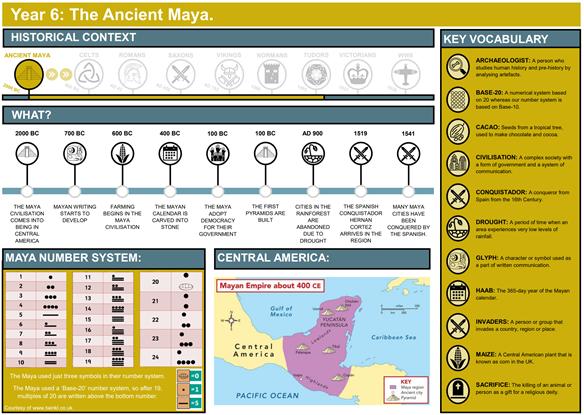
@hwrk_magazine 18 // HWRK MAGAZINE // J AN u AR y 2023
PEDAGOGY
There is a discussion as to whether knowledge organisers are applicable to KS1 children and what they can gain from them. For me, there are many reasons why they have a place in a KS1 classroom as much as they do elsewhere.
Firstly, there is the need for all schools to have high expectations of children, especially those of a younger age. By providing examples for KS1, we are increasing the expectations of how we want children to access their learning. By providing this expectation early on, children also have the opportunity to become familiar with the structure and layout at an early age. There should not be anything on here that won’t
be covered during the unit itself so there is nothing that children won’t eventually become familiar with, regardless of what year they are in. Note the use of high order vocabulary – palaeontologist for example. This is not an oversight. Whilst it is not expected that the children know how to spell the word from memory, what we should expect is for an understanding of what a palaeontologist is and their role within the unit.
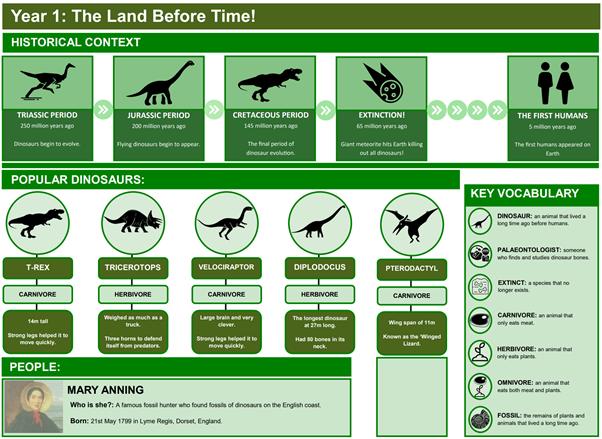
Explanations need to be clear, however, so that children are not overloaded with lots of information. Working memory is limited and so the inclusion of just the vital elements of the unit is important
here. As is the inclusion of dual coding theory, similar to other knowledge organisers. There is a need for more examples of this to be included in younger year groups so that children are able to make more visual links. Therefore, a more visual experience, but one that still has a place and a purpose within the curriculum.
As has already been stated (but cannot be overstated), knowledge organisers support teachers in the classroom when it comes to planning, teaching and assessment. However, children need to be given the opportunity to engage with them.



J AN u AR y 2023 // HWRK MAGAZINE // 19 HWRK MAG AZINE .co.u K PEDAGOGY
*Focus on vocabulary – what do you want children to retain? Make sure that the definition is in child speak as the word in isolation means nothing.
*Share them – make sure that knowledge organisers are not just tucked away and forgotten about. Refer to them regularly and increase their importance through regular retrieval practice.


*Refer to prior learning – as with all retrieval practices, there should be regular opportunities to refer to prior knowledge from units taught across the school. Make sure that children see the links and the purpose for what is being taught. This can be achieved in many forms like links to historical concepts or the effective use of dual coding on a knowledge organiser.
One way of supporting this outside the classroom is by sharing them with parents. The way that we have done that is by sending these to parents via our school bulletin with a pre-amble as to what they are and how they can be used effectively to support the learning of the children. We also state how parents can be supporting the acquiring of key knowledge with their children.
Sharing these at home also promotes revision techniques and independent study as we ask for these to be printed and pinned to the fridge or bedroom wall with the hope that discussion around the dining table can also be had. In a world dominated by screens and digital media, we see this as a great way for families to demonstrate their knowledge and understanding of a unit together.
As with anything, the impact of knowledge organisers in the primary classroom is only as successful as how they are used and applied. I have compiled some quick ‘dos and don’ts’ when creating and implementing these to provide a useful guide for their use.
*Ensure consistency – I have made the decision to create all of these for my school, but there isn’t a reason why a working party couldn’t produce something of a similar quality. What is important is that everyone involved in the process is aware of what should be included. *Include an overload of information – keep the information important and key. You cannot include a whole unit’s knowledge on a knowledge organiser so keep it important. If there is too much information, the organiser itself becomes a distraction.
*Think that sticking into books is enough – it is a common downfall of the knowledge organiser. They are stuck in books and forgotten about. Make sure that they are referred to and acknowledged regularly.
*Let children use them in retrieval tasks – for children to get the most from knowledge organisers and to be taking in the information from them, when they are quizzed, by having access to them, children are not remembering key information, but are just copying what has been produced for them. You will only know the impact that a knowledge organiser is having when it is not available for children to use.
*Differentiate them – apart from the obvious workload issue, all children should be able to access a knowledge organiser no matter their ability or SEND need. As the organiser contains all of the key knowledge for the unit, if you differentiate these, you are ultimately depriving some children from access to key knowledge that others would have available to them.
@hwrk_magazine 20 // HWRK MAGAZINE // J AN u AR y 2023 PEDAGOGY
do
t
don’
24. Creative Writing and Self-Regulation
How can we make a challenging task like creative writing more manageable? Jennifer Webb suggests some strategies to “shrink” it, to help students focus on what matters.
32. How I Would Teach Creative Writing For AQA
English Language Paper 1
Andrew Atherton offers his advice on how to get students started with creative writing when they don’t know how to begin.

37. What I’ve Learnt From Recording 100 RE Podcasts
Louisa Smith is the host of The RE Podcast. In this article she shares some of the most interesting things she’s learnt…
40. Teaching Times Tables
A winning strategy for teaching times tables

EXPAND YOUR MIND ONE SUBJECT AT A TIME JANUNARY 2023 // HWRK MAGAZINE // 23 @hwrk_magazine
Creative Writing and Self-regulation


How can we make a challenging task like creative writing more manageable? Jennifer Webb suggests some strategies to “shrink” it, to help students focus on what matters.
 By Jennifer Webb
By Jennifer Webb
Self-regulation is an act of awareness – being aware of: what you are doing; how you are doing it; why that is; actively considering how you might do it better, and adjusting your own behaviours accordingly. In The Metacognition Handbook, I defined self-regulation as: ‘the learner’s ability to plan, monitor and evaluate their own learning whilst completing the task itself (…) actively applying metacognitive knowledge in real time.’ (Webb, 2021)
The self-regulating student is the ultimate goal. They:
- know what success looks like
- know their own tendencies and weaknesses
- have a clear sense of what they are going to do
- are able to self-correct at the same time as doing a complex task

- take ownership of their learning and work output
The problem with creative writing:
1. Creative writing is creative. How can students have a ‘clear sense’ of anything when the final product is inherently creative and, as yet, undefined?
2. Writing is an extremely complex set of processes. How can students know enough of their own weaknesses when there are so many potential areas of the craft to work on?
3. ‘Success’ in this arena is, arguably, subjective.
These problems are real. Creative writing is a challenging term. We tend to use it in the English classroom to denote anything which is not a literature essay or piece of functional ‘transactional’ writing, such as an article or an advert. That is, anything which does not have a distinct purpose. This is difficulty because some might argue that ‘creative’ writing is the most purposeful of all – it transcends the
mundane everyday experience and functionality required to exist in the word and is, essentially, art. What could be more meaningful than that?

In my view, the only way to tackle the broad and infinite possibility of ‘creative’ writing is to shrink it so that it is classroom sized. This is not about limiting student ambition or putting a ceiling on their efforts. It is simply about selecting a small focus area and working at that in a conscious, deliberate way.
English teachers teach writing all the time. Writing is a skill we continue to hone, even when we are teaching something which is traditionally considered a ‘reading’ topic. Even when we teach a novel or a poetry unit, students will use writing as a servant strategy to develop their notes and thought processes, and also as a way to express their ideas in more formal academic writing. When teaching any kind of writing, I have a set structure.
CURRICULUM @hwrk_magazine 24 // HWRK MAGAZINE // J AN u AR y 2023
Writing unit principles:
These are the key principles I apply when planning and delivering a writing unit. The examples alongside are from a Gothic writing unit I recently taught to Y7. It was their first explicit writing topic of secondary school.
1. Set intention
Choose a narrow, specific set of knowledge and skill which you will focus on developing during the unit. Ensure that this is something which is borne out of your knowledge of the students and where they are. I usually select:

• 2-3 areas of knowledge and skill which are new
• 1-2 areas of knowledge which are a continuation of a previous unit
• 1-2 things which have been misconceptions which I want to continue to reiterate as we go along
EXAMPLE
Intentions for the unit:
2-3 areas of knowledge and skill which are new
- Exposition (creating atmosphere and setting tone)

- Pathetic fallacy
- Foreshadowing
1-2 areas of knowledge which are a continuation of a previous unit
- Modification and expansion (building on knowledge of word classes, function and clause structure from Y6)
- The Gothic (building on reading unit from September)
1-2 things which have been misconceptions which I want to continue to reiterate as we go along
- Fragmentation
- Concrete/abstract nouns


- Run-on punctuation
2. Live models which springboard CHOICE
Ensure that all modelling is done live under a visualiser, highlighting the skills and knowledge which you are chosen as your intention. Ensure that there is dialogue about what is written, how it is written, what else could be written and which the students prefer…
I modelled live almost every lesson. There were a range of models, from single word choices in single sentences, to longer descriptive pieces. Often there would also be opportunities for me to put student work under the visualiser and model marking and feedback, or model how their writing might be enhanced. By the end of the unit, a handful of students had also been confident enough to come to the visualiser themselves and model a skill for the group.
HWRK MAG AZINE .co.u K J AN u AR y 2023 // HWRK MAGAZINE // 25 English
Examples of some models:
This demonstrates the difference between a descriptive sentence (top), one with a modifier (silver), then with the modifier moved so that it is post-modifying, then with expansion (addition of a phrase: silver with age), then with that phrase moved so that it is fronted.


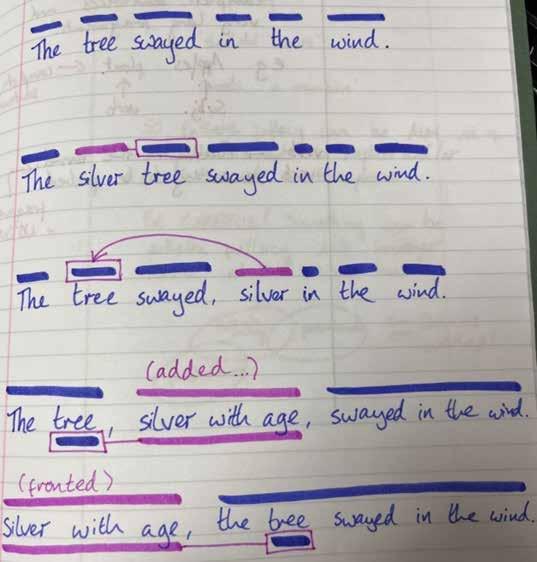

CURRICULUM @hwrk_magazine 26 // HWRK MAGAZINE // J AN u AR y 2023
This model shows students how we might write using more precise nouns and verbs – dog becomes wolf; moving becomes stalking; road becomes alleyway.
With each of these models I ask questions like:
- How does this new element change the meaning?


3. Reflection wraps practice
- What would a different choice look like?
- Which one do you prefer?
- Does this capture what we want to say, or is there still something which isn’t right?
All the time, we are stressing the importance of choice in writing.
There are many, many options open to students – there is no right answer here. The only ‘right’ answer is the one which most closely voices what they really want to say. I would highly recommend the work of Myhill and the team at Exeter University to anyone interested in Grammar as Choice Pedagogy: https://education.exeter.ac.uk/ research/centres/writing/grammarteacher-resources/grammaraschoice/
Prompt student reflection before they write, while they write and after they write. Ensure that the reflection is precisely linked to the unit intentions.
I used a four-part frame to scaffold student reflection before, during and after writing. They just take a page I their exercise book and divide it into four.
Comprehension
Students write down what they understand the task to be – e.g. it will be three paragraphs of prose describing a tree in a park. It will use X devices, etc.
Strategy
What is their ‘battle plan’ for this task? This should be a really clear, simple breakdown of what they will do in order. There might also be some reminders here about what they might do to avoid specific errors they tend to make, e.g. checking for capital letters.
Connection
Students reflect on when they have done something like this before – how did it go? What were their errors or areas for development? How will they build on previous successes and learn from previous weaknesses?
Reflection
This is completed AFTER the task has been done and feedback has been given.
How did it go? What were the key successes? What prompted them? What were the key areas for improvement? How might they be tackled in future? Did my ‘strategy’ work? How will it change next time? What questions do I have? What are my priorities moving forward?
This reflection enables students to process all their key understanding before beginning. It then also acts as a prompt during the writing process. When students are first learning to self-regulate, I remind them at intervals during their independent writing, to look back at their reflection plan and ensure that the strategy and key areas of focus are at the forefront of their minds. We also return to it explicitly during the proof reading stage before students hand in.
HWRK MAG AZINE .co.u K J AN u AR y 2023 // HWRK MAGAZINE // 27 English
4. Promote the practice of ‘book dialogue’
Train students to have an ongoing conversation with their exercise book. This means that they are in the habit of writing notes and commentary in the margin of their exercise book as they go along.
5. Insist that the piece of writing isn’t the point – it’s all about the ongoing craft
Highlight the idea that they aren’t working on a piece of writing, but on themselves as writers. The work in their book is their working memory externalised, not a shiny, polished, finished piece. Ensure that each shorter writing task pulls through to the next, and that it is a continuous thread of skill development.
These two steps are critical and inextricably linked to one another. A piece of student writing is NOT a perfect, publisher-ready manuscript which should be put on a pedestal. The process of writing itself is generative and messy. I liken writing to painting or clay modelling –students need to see that you have to make a mess, make errors, cross out and reflect on your work at intervals in order to craft something effective. A beautiful tidy book is not the endgoal, here.
An exercise book is:
- A space to work out problems
- A space to try out techniques


- A space to jot down ideas, externalising them and extending your working memory capacity so that you can build and develop your thinking.
- A space to draft, reflect and re-draft
To get students thinking like this, we need to change their mindset about their writing. This is what I did in this unit.
CURRICULUM @hwrk_magazine 28 // HWRK MAGAZINE // J AN u AR y 2023
Book dialogue:
- After their first drafted piece of writing, I asked students to highlight the sentence they were least happy with and write a comment in the margin about why.
- After their next draft, I asked them to do the same for two sentences AND a word choice they were unsure about.
- During the next draft, I ask students to just make any notes about uncertainty or challenges they experience in the margin as they go. I model this under the visualiser, and show them, for example, how I might highlight a word and make a note in the margin to show that I want to come back to it because I’m not sure it’s the right choice.
- Over time, I built this into a consistent part of their writing – students didn’t need to be asked to do this by the end of the unit, because they were doing it automatically.
Ongoing craft:
Over the course of the unit, I was aiming for students to develop one or two really strong pieces of writing. This might have become repetitive or static, had it not been about writing short pieces and then tying things together and synthesising their shorter pieces. This is what I mean…
Writing task 1: A short, literal description of a scene as depicted by a photograph they had brought in.
Writing task 2: Taking task 1 and transforming it into a gothic description by changing specific elements of lighting and temperature.
Writing task 3: Looking at a model exposition (the opening to Rebecca), and then reflecting on task 2 and how it might be improved to create a more compelling atmosphere.
Writing task 4: Students looked at pathetic fallacy as a technique, and wrote a paragraph using pathetic fallacy. They then found a way to combine this with their work from task 3. They reflected on things they should keep, things to discard and things they might want to introduce in order to make those two pieces of writing work together.
This is just a short example of how this might work from one piece to another in a continuous thread. This is something which we sustained across the whole unit, so that students could develop ideas from one piece to the next, but also introduce new ideas and experiment with new things.
Fundamentally, creative writing requires a firm foundation of knowledge, paired with the mindset of someone with agency over their own work. By giving students excellent explicit instruction in areas of key knowledge, and demonstrating high level models and processes, we provide the base.

But this knowledge alone is nothing. Students must take that knowledge and have the confidence to play with language, make choices, change those choices and see themselves as writers.
It is so easy for writing instruction to become a stale series of exercises where the teacher models and students mimic. However, when we have an open dialogue about choice and self-regulation, our young people actually become writers.

HWRK MAG AZINE .co.u K J AN u AR y 2023 // HWRK MAGAZINE // 29 English
How I would TeacH creaTIve wrITIng For aQa englIsH language PaPer 1
Andrew Atherton offers his advice on how to get students started with creative writing when they don’t know how to begin.
 By Andrew Atherton
By Andrew Atherton
A blank piece of paper can be a fearsome thing. Liberating to some, but anxietyinducing to others. Nowhere is this more apparent than with creative writing. I imagine accosting a comedian whilst they’re shopping, a trolley filled with the weekly groceries, and insisting that they tell me a joke. Something splutters out, a half-joke, not really funny, and they limp off, back to the cereal aisle. Being creative on cue is never an easy task, but yet this is what is demanded of our students. ‘You have forty-five minutes’, their GCSE intones, ‘now be creative! Go!’ The clock starts to tick, louder than any clock should.
How can we help our students to crack this? They can’t rely on creativity striking at 9am on a random Friday in May. How do we transform a blank piece of paper from a source of angst to a source of enjoyment? One answer lies in teaching, rehearsing and modelling certain generative structures that students can depend upon, both to shape their response and to plan it.
Such structures not only prime student thinking, giving them a much needed starting point, but they feed forward into the piece of writing. This article outlines one such structure that you can use with your own students, either as something to rehearse or to model.
A Photograph Finish…!
This strategy works best with a question that asks students to respond to an image, an increasingly common style of question. However, even if it doesn’t use this format, students can still utilise this structure. For ease, we’ll imagine the student is presented with some kind of image or photograph.
This structure works by imagining that you, as the narrative voice, are holding this image (whatever it is) as a photograph or, if it fits better with the task, a work of art. The given image is not just an image, but a photograph or a framed piece of art. Whatever the image is, students can just imagine it is framed and that they are physically holding it
in their hands. This initial premise can offer students so many ideas and directions, which is precisely why it works well. Let’s consider what could happen next, as a series of four steps.

Step 1 - The Photograph
Students begin with a description of the physical photograph itself. What might they begin to think? Is it torn? It is fading? Is it recent? Do the edges slightly curl after many years of being looked at and handled? Is it colour or black and white? Is it in a shoe box or a family album or a decorative photo frame? How does it feel in the hand? Light like a feather or somehow heavy? What does it smell like?
If the given image is a painting then has it been rolled up or is it proudly displayed in a frame? Here, students are not describing the image, or perhaps just in passing, but rather they’re describing the perimeter or parergon of the image: its physical, corporeal existence as you hold it in your hand.
CURRICULUM @hwrk_magazine 32 // HWRK MAGAZINE // J AN u AR y 2023
Step 2 - Your Hands
Now, students have two options, one of which I much prefer. The first option is to zoom into the image itself and describe the scene a little. Again, perforating any description with reminders that the narrator is holding it physically in their hand. It has a weight to it. A sensation.

The second option, though, and my preferred one, is to zoom into the hands holding the photograph. What do they look like? How are they holding it? Do they tremble? Do they clutch? Do they hold it at the fingertips, almost pinching the photograph? Are these hands wrinkled? Are they young? Are they cracked? Knotted? Knuckled? Do these hands hold it closer or at a distance?
This could turn into a masterclass of ‘show don’t tell’: what can we suggest to the reader about (1) this person, the ‘I’ of the response, and (2) their relationship to whatever it is they are holding? How can we tell a story without actually telling it?
Step 3 - Origin Story
At this point, students deal more directly with the image itself. The ‘I’ of the piece now recalls via a flashback the day the photograph was taken. What was happening? Where was it? What was the weather like? How long ago was it? How did they feel? Who else was there?
Students begin to build a sense of the narrator’s relationship to the image, engaging with wider ideas of transience and memory. If earlier in the piece the photograph was described as having crumpled edges from being looked at and handled over many years, what was it about this day that caused it? Why is it important?
Students might now shift into description of a more traditional kind as they cast their narrative gaze over the landscape, the sounds, the smells, the people, the weather,
the colour of the sky, and how this makes the narrator feel and why it has reverberated in their mind over the years.
Step 4 - Lay to Rest
Students now return to the physical artefact of the photograph. The narrator is holding it again. What do they do with it? Do they lay it gently into a box? Do they crumple it up and shove it back into a shoe box, watching as the lid folds darkness around it? Do they hold it close? What are their hands doing? How do they feel? The final action the narrator takes tells the reader a lot about the relationship they have to this photograph and what it depicts.
Why Does This Work So Well?
There are a few reasons I think this approach works so well. Here are just a few:
1. It provides students a set of prompts and self-generated questions to cue their thinking as they write and plan: How does the narrator hold the photograph? When was it taken? Who was there? What was the weather like, and so on. For students that may struggle to find a way into their creative writing, this set of cues is absolutely groundbreaking. Suddenly they are free from trying to devise a ‘set up’ to their piece and can focus instead on their control of language and choice of imagery.
2. It almost has built in some of the features that often characterise a top response: a central motif that runs throughout the piece (the idea of a photograph), perspective shifts (from the photograph to the hands to the flashback), a tightly controlled structure (photograph, hands, memory, photograph), as well as a bank of imagery related to time and memory to call upon. But, again there is more than enough creative space for students to transform this premise and shape into something genuinely imaginative and emotive.
HWRK MAG AZINE .co.u K J AN u AR y 2023 // HWRK MAGAZINE // 33 English
3 . Indeed, following the above, it offers a conceptual thread to their response that is really important but difficult to pin down: time and memory. If we imagine the shift from wrinkled hands holding the photograph to youthful hands the day it was taken, embedded into this is a potentially incredibly powerful meditation on the transience of time and the memories we hold onto. Equally, describing the photograph at the start as having curled, faded edges again taps into this. So, it gives a substantive shape to something, by its nature, very abstract and conceptual.
4. Another aspect of this approach that I really like is that it again has embedded within its structure really effective opportunities for inference and ‘show don’t tell’. If we wish to express sadness, we don’t need to say this and instead we can describe how the hands ‘trembled’ whilst ‘clutching onto the edges of the photograph, a fresh dampness falling onto the plastic film and bringing to life once again the rain suspended by the camera’s click’.
Students can imply the relationship between the narrator and the image by how the narrator handles and touches the physical artefact. It is again making concrete something that is often very abstract, and providing the cues that help students to think about it.
5. One final aspect of this overall strategy that I think is great is the opportunity to teach students about ekphrasis. We can talk about how this basic idea (a descriptive piece about holding a photograph or work of art) taps into a rich repository of literary work broadly aligned to ekphrasis. We could, for instance, introduce this approach alongside Keats’ ‘Ode on a Grecian Urn’, exploring how Keats too imagines a moment caught in time and how he also uses this to explore ideas such as the transience of time.
Now, whether or not you aim to teach this as a set shape or framework for students to use in the exam itself, there is of course another benefit to this strategy. A benefit for us. In the same way this approach offers students a set of

prompts to think their way through a response, it also offers us a series of cues to help model creative writing.
Whenever I am introducing creative writing at GCSE, this shape tends to be the first full example I model to students. It works exceptionally well for this as it demonstrates and elucidates many of the typical characteristics of an excellent piece of descriptive writing as well as offering a set of ready-made cues to help me to verbalise my thought process as I live model.
Given there are so many different ways we could take this response, it also offers enough freedom for students to add their thoughts as we do it together and even produce a follow-up with a different image.
This basic shape, as well as the ideas it helps to generate, will ensure students always have at least a starting point. Now when they’re told to be creative, they’ll at least have a punch line.
CURRICULUM @hwrk_magazine 34 // HWRK MAGAZINE // J AN u AR y 2023
What I’ve Learnt From recordIng 100 re Podcasts

 By Louisa Smith
By Louisa Smith
In October 2020, I started
The RE Podcast. I had no idea what I was doing, whether it would work and didn’t conceive that 2 years later I would still be doing it, and that people would value it. All I knew was that, after 20 years in the classroom, I wanted to do something creative outside of my teaching day job.
In short, The RE Podcast has changed my life. It has given me purpose, it’s improved my teaching, it’s reinvigorated my passion for education and RE, and it has connected me with so many wonderful people. I honestly feel so humbled and privileged.
As I approach my 100th episode, I am naturally reflecting on what has been created and what I have learnt.
Obviously I have learnt how to do a podcast, how to edit it and how to promote it! I had to learn from scratch!
But on a personal note, I have learnt that I am better than people told me I was. It feels like this is what I was meant to do. I have had to overcome fears and challenges but it uses all my skills - I am a natural communicator, I am an extrovert, and I am a total geek. I am also not a details person - I don’t sweat the small stuff, so creating the podcast never causes
me stress because I don’t have unnecessarily high expectations, and I don’t mind if it’s not perfect. Things just sort of fall together.
I am really good at time management and organisation but not in a way that stifles creativity. I have always been criticised in the past for not being tidy, but I think this is key to my success - if I was too organised, I would not be able to achieve all the things I do. I am happy to have an untidy house, I am happy to interview someone when I haven’t had time to research fully because I have developed skills throughout my life to adapt when things don’t quite go to plan.
hwrkMAG A zine.co.uk J A nu A ry 2023 // hwrk MAGA zine // 37
Religious Education
Louisa Smith is the host of The RE Podcast. In this article she shares some of the most interesting things she’s learnt…
The second thing I have learnt is that The RE Community is incredible. For 21 years, I had no idea there was such a rich and diverse support network out there. Twitter has connected me with other RE teachers, RE charities, RE resources and authentic people living out the faiths that I teach. This is by no means an exhaustive list but my thanks goes out to”
- Adam Robertson
- Ash Kundi
- Claire Clinton
- Culham St Gabriel and RE Online with Kathryn Wright and Kate
Christopher
- Dawn Cox
- Dr Jasjit Singh
- James Holt
- Jennifer Jenkins
- Katie Gooch
- Molly Acharya
- Nikki McGee
- Religion Media Center
- Shuaib Khan
- Teacher Hug Radio

- Theos Think Tank
- Waqar Ahmedi
- Zam Hussain
The third thing I have learnt is how to teach more accurately and authentically. I have always felt insecure about teaching any other religion except Christianity, due to my upbringing.
I have had so many generous people give up their time to discuss their faith with me.
The Top Ten things that I have learnt:
1. The books of Acts was written before the Gospels
2. There is a Religion Media Center and they are awesome
3. Intersex affects the same number of people as those who have green eyes
4. There is something called Sunday Assembly which is like Church but non-religious
5. There is a free RE Leadership Course for RE teachers who want to progress their career
6. How to decolonise my lessons. Before I started The RE Podcast, I didn’t even know I needed to decolonise my lessons, actually, I didn’t know what the word meant. But thanks to Ash Kundi and our series of 5 episodes on the Decolonisation of RE, I know we have given the RE Community clear and simple ways to do this.
• Let’s change Hinduism to Hindu Dharma as Hinduism is the name given by colonialists to describe a variety of beliefs and cultures centred around the Indus River
• Let’s use Sikhi (pro. Sick-ee) instead of Sikhism, and pronounce it ‘Sick’ not ‘Seek’
• Let’s use Allah instead of God when when teaching Islam
• Let’s not assume Siddhartha Gautama was an historical character,
• Let’s use ‘awakened’ instead of ‘enlightenment’ (an obviously colonial word)
• Let’s use Yeshua when talking about Jesus in Judaism
• That the negative stereotype of the caste system is a colonial hangover, and the reality of it is that people have different roles to perform to allow society to function, and all societies have this.
7. I have had many wonderful Muslims on my podcast who have talked wisely and openly about their practice. I have learnt so many things from them.

• That Ramadan breath is a thinganecdotes like that help what you teach feel real
• That during Eid Ul Fitr Muslim children decide which ‘aunty’ to go to based on whether they give you sweets or money
• That Allah does not record bad deeds in your book of deeds straight away, he waits to see if you make amends, and if you do, it doesn’t get included!
CURRICULUM @hwrk_magazine 38 // hwrk MAGA zine // J A nu A ry 2023
• That Ahmadiyya is part of Sunni Islam
• That ‘akhirah’ means what comes after - so could mean what happens tomorrow
• Why Ashura is so important to Shi’a Muslims because every day is Ashura and every land is Karbala. And how important Ashura is as a counter to toxic masculinity
• How empowered Muslim women are!
8. I have learnt a lot about the heteronormative lens with which some people view the Bible from gay vicars and from vicars who marry gay couples. If Jesus was God in the beginning and became a man, is he a trans male? If God created land and sea, but also marshland, night and day but also dusk, does this mean creation is on a spectrum? So if God created male and female, there can also be a spectrum of genders?

9. When I interviewed the jihadist, I saw the human behind the label. I learnt that we can’t treat extremists as cartoon evil villains. Extremists are varied, there is no one profile, but there are common factors. Often starting with marginalisation. If we marginalise certain groups within society, and push them away, then they become more vulnerable to the pull of extremist groups. I have spoken to a lot of Christians who are concerned about the level of homophobia, racism and sexism within the established Church. While I am sure this is not particular to just one established religion, or even just from within religion, it is something which many of my Christian guests commented on from within that religion, but it was comforting to know that there are people within Christianity who are challenging the historically bigoted and narrow-minded views.
10. A common theme with nearly all the guests I have on the podcast is the importance of talking to people who think differently from you, not in order to change their mind but in order to open your own. I have recently come across a book called ‘I May Be Wrong by Björn Natthiko Lindeblad. This is a challenge to me as a human, a teacher and a parent. I made the conscious decision to not be contrary or antagonistic in my approach to interviewing people with different opinions to my own. In this way I wanted to model to the listeners how to consider different points of view in a respectful way - to create connection and communication rather than polarisation and conflict.
I was once asked in an INSET session to tell the person next to me something of which I am most proud. Then, I couldn’t think of a single thing, but now I can. I have learnt that manifestation works. I manifested The RE Podcast! What would you like to manifest?
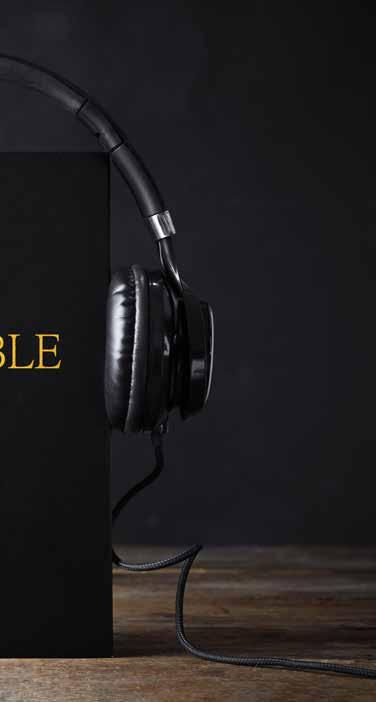
hwrkMAG A zine.co.uk J A nu A ry 2023 // hwrk MAGA zine // 39 Religious Education
How I would TeacH MulTIplIcaTIon TIMes Tables
Jon Bee discusses the pros and cons of using counting sticks to teach multiplication times tables
 By Jon Bee
Multiplication times
By Jon Bee
Multiplication times
tables are too important to be left to chance. A clear, systematic approach is needed across school in order to support all children to recall times tables facts, both quickly and reliably.
Children need to be fluent with multiplication times tables in order to access much of the Maths curriculum. Without fluency
and quick recall of multiplication times tables facts, maths becomes unconnected and confusing. Sounds of ‘I can’t do Maths’ may ring out around our classrooms.
Leaving times tables to chance will also limit access to the wider Maths curriculum. So how might we teach children multiplication facts so that they can remember them reliably and fluently and to recall them in

order to access the curriculum? Enter: the counting stick.
Counting sticks are not new to classrooms, but reimagining their use can allow children to access and thrive.
The counting stick should be held in the middle to anchor the times tables facts (shown by an arrow in the image).
CURRICULUM @hwrk_magazine 40 // HWRK MAGAZINE // J AN u AR y 2023
• This counting stick supports children to skip count multiplication times tables whilst looking for patterns and links.




• Children should be encouraged to count forwards as well as backwards.
Choose the times table to focus on and use some post-it notes or stickers to write down the times tables and present them on the counting stick. Skip count forwards and backwards.
• The arrow anchors children to the mid-point of a times table. This counting stick has 12 equal parts but most physical counting sticks have only 10.

• Each new screen transition removes some facts and encourages children to remember by making links and connections with multiplication times tables facts.
Tell children they know we always start at 0 and they know we’re doing the (in this case) 7 times tables and we already know 7 x 10 = 70.
Keep removing the post-it notes or stickers each time you count through. This will allow children to remember the times tables.
The process continues until all children have recalled the times tables out loud without any numbers on the counting stick.
It may then be repeated later that day, the next day or the next week. You can focus on any timetables based on teacher judgement and assessment.
Using a counting stick allows for an explicit and systematic approach to teaching multiplication times tables. You may make links between the patterns and connections in the multiples. Introduce language such as factors, multiples, product, double, half and square numbers.
Advantages of using a counting stick:
1. Concrete representation: Counting sticks provide a concrete representation of the numbers being multiplied, allowing students to physically manipulate the sticks and see the relationship between the numbers. This can help students who struggle with abstract concepts to better understand multiplication.
2. Visual aids: Counting sticks can be used as visual aids to demonstrate the concept of repeated addition, which is often used to teach multiplication. This can help students see the relationship between
The removal of post-it notes allows children to commit tables to their long term memory. Repetition is key, so practicing for a short period at the start of lessons, start of the day, straight after lunch or before home time can be really powerful. Combining this approach with songs, rhymes, looking for patterns can strengthen understanding.
multiplication and repeated addition, and understand that multiplication is a way of finding the total number of objects in a group.
3. Hands-on learning: Counting sticks are a hands-on tool that allows students to be actively engaged in the learning process. This can help to increase their interest and understanding of the concept.
4. Multiplication facts memorisation: Using counting sticks to teach multiplication can be a great way to help students

memorise their multiplication facts. For example, students can use a counting stick to practise and memorise the 2’s multiplication table by counting in 2s.
5. Multiplication with larger numbers: Counting sticks can be used to represent large numbers and help students to visualise the process of multiplication with larger numbers.
6. Reinforce the concept of place value: The use of counting sticks can help students to understand the concept of place value and how it relates to multiplication.
HWRK MAG AZINE .co.u K J AN u AR y 2023 // HWRK MAGAZINE // 41 Maths
Things to consider:
While there are many advantages to using a counting stick to teach multiplication, there are also some potential disadvantages to consider:
1. Limited to basic multiplication: Counting sticks may not be as effective for teaching more advanced concepts such as long multiplication or multiplication with decimals.
2. Inability to demonstrate more complex problems: Counting sticks may not be able to demonstrate more complex problems that involve larger numbers or multiple digits.
3. Requires physical resources: Counting sticks are a physical resource that may not be readily available in all classrooms. Teachers may need to spend time and resources creating their own counting sticks or purchasing them.
4. Limited to one-digit multiplication: Counting sticks are limited to one-digit multiplication, which may not be enough for students who need to work with larger numbers.
5. May not be suitable for younger students: counting sticks may be too advanced for younger students and may not be appropriate for students who are just learning their numbers.
In summary, teaching multiplication with counting sticks can lead to misconceptions such as multiplication is just repeated addition, multiplication and division are inverse operations, multiplication is only for whole numbers, counting sticks can only be used for basic multiplication and counting sticks are the only way to teach multiplication.
It’s important for educators to address these misconceptions and provide a variety of teaching strategies to help students understand the concept of multiplication.

When teaching multiplication and times tables, a variation theory approach can be helpful. This approach focuses on understanding the underlying patterns and relationships in multiplication, rather than just memorising facts.

By understanding the patterns and relationships, students can better understand the concept of multiplication and find it easier to remember the times tables. Additionally, it can also be beneficial to use a variety of teaching strategies and resources, such as visual aids, hands-on activities, and real-world examples, to help students understand the concept.


CURRICULUM @hwrk_magazine 42 // HWRK MAGAZINE // J AN u AR y 2023
LEADERSHIP
46. What Exactly Is School Culture?
School culture can make or break a teacher. Shannen Doherty sets out what leaders needs to be mindful of when developing culture at their schools.

48. Effective CPD Design For Teachers
How can we design highquality CPD for teachers?

Amarbeer Singh Gill offers his suggestions on how to create CPD that is meaningful and effective.
53. Developing Expertise Through A Coaching Curriculum
Sam Gibbs offers suggestions on how to build an effective coaching curriculum to support teacher development.
hwrkMAG A zine.co.uk JA nu A r Y 2023 // hwrk MAGA zine // 45
What Exactly Is school culturE?
School culture can make or break a teacher. Shannen Doherty sets out what leaders needs to be mindful of when developing culture at their schools.
By Shannen Doherty
Some years ago, I probably naively ignored the climate that was being created in the first school where I taught. I can now look back and see that with a new headteacher in place, lots of work was being done to unite a team and ensure our core values aligned as well as allowing staff the breathing space to be themselves. This culture was integral to the rapid improvement of a school that was showing some cracks. Priorities were set out. Standards were raised. Leaders were visible.
Having taught in four schools across three London boroughs and spent a lot of time in different schools in and out of my multiacademy trust, I have been fortunate to see and experience a range of cultures at work.
I’m nosy by nature so I have spent a lot of time behind the scenes (or trying to worm my way back there) to see the cogs turning. How are decisions made? How are they communicated? When do leaders consult staff? When do they sell it to them? When do they just tell them? This stuff fascinates me.
So, when thinking about workplace culture in schools, I headed to the standard dictionary definition that is “the customs and beliefs, art, way of life and social organisation of a particular workplace”. This is definitely true. Culture comes from a shared moral purpose and a shared vision, which is rooted in trust.
However, culture is not just about shared values and norms. I also wanted to consider

another side to the culture coin. Culture comes from the Latin word ‘cultura’, which means growing or cultivation. If we want crops to grow, we need the conditions to be right. Any Year 3 child could tell you that! Likewise, if we want our schools and staff to grow, then the conditions need to be right. This isn’t a game of chance or luck. It involves careful curation and nurturing of a range of customs and beliefs that shape our environment.
Stoll and Fink’s research at the Institute of Education (1996) shows that school cultural norms are vital for all adults and pupils to thrive. They found ten cultural norms that influenced school improvement.
Ten cultural norms
2.
But culture isn’t just a list of values or ideas printed on a sheet of paper that gets handed around each September. It must be lived, breathed and experienced. Culture is ever-changing. It isn’t static. Its core might remain the same, but it’s likely to transform and fluctuate as time goes on and as staff change.
This stuff matters. There’s no two ways about it.
When culture goes wrong
There are countless horror stories of the impact that a negative culture can have on staff. While there’s always two sides to every story, we must acknowledge that some leaders do get this stuff wrong. Social media is full of teachers at the end of their tether with toxic workplaces.
Having scrolled through numerous online teacher groups for the last couple of months, I have seen:
• a teacher who is made to feel guilty for being off work ill
• someone being told they won’t be paid if they want to go to their child’s nativity performance
• someone asking what hours everyone else works because they do 7:30am-5pm and have had comments made about their dedication to the job
• an early career teacher explaining that their mentor regularly calls them a cause for concern
• countless teachers crying over nasty and unhelpful feedback in observations
• a teacher overhearing her head and deputy calling her names
@hwrk_magazine 46 // HWRK MAGAZINE // JANUARY 2023
goals
1. Shared
Responsibility for success
Collegiality
Continuous improvement
Lifelong learning
Risk taking
Support
Mutual respect
Openness
Celebration and humour
3.
4.
5.
6.
7.
8.
9.
10.
• a senior leader berating staff for booking something in the hall on the day he wanted to use it
• a new teacher in the staffroom listening to other staff making unkind comments about leaders and saying they just don’t care about the job that much
…the list could go on. This barely touches the sides!
The saddest thing is that some of the comments suggest these people should just put their head down and get on with it because it might be worse somewhere else or it’s just part of the job.
I am sure that the positive experiences outweigh the negative. But that doesn’t make it ok. 99 out of 100 schools with a positive culture is not good enough. No teacher should go to work worried about what will happen that day. People deserve to feel psychologically safe in their workplace.
The negative impact of a toxic culture in school could also be detrimental to the education of its students, which is devastating when you consider that educating children and young people is why most of us are in this job.

Let’s look at positive culture
A positive school culture results in teachers who are excited to teach, who feel valued and invested in, and who want to try things out because they want the best education for their pupils. Positive workplace cultures involve all of the norms that Stoll and Fink discuss. Staff feel like part of a team. Work is enjoyable; people laugh! There is a shared vision and purpose. Nobody feels unsure about the reaction they’ll get if they suggest something new.
So, what do we do and whose responsibility is it?
Ultimately, the culture of school starts and ends with its leaders. Leaders need to take the temperature of the current culture in their school and consider which of Stoll and Fink’s ten norms are already in place and which aren’t. All of the staff have a role to play in ensuring the culture ticks along, but the leaders are responsible for setting the tone and working with any bad eggs on moving them forward to become part of the team.

I don’t think I’ll shut up about this until I stop hearing wild stories of leaders on power trips who have cultivated a negative climate. Nobody is perfect and we all make mistakes, but human error and negative emotional reaction shouldn’t become deliberate choice.
Finally, if you do find yourself in a toxic environment, please know that there are better schools out there and you do not need to suffer in silence.
JANUARY 2023 // HWRK MAGAZINE // 47 HWRK MAG AZINE .co. UK LEADERSHIP
EffEctivE cPD DEsign for tEachErs
How can we design high-quality CPD for teachers? Amarbeer Singh Gill offers his suggestions on how to create CPD that is meaningful and effective.
 By Amarbeer Singh Gill
By Amarbeer Singh Gill

It’s the first day of the academic year and our T&L lead, Harpreet, is eager to get into the INSET day training. Over the summer Harpreet came across an article about the benefits of spaced practice1 which they’ve used to plan their upcoming INSET day…
A journalist once said this about highly successful football manager, Carlo Ancelotti: “He knows a truth about top-level football: most players don’t need to be motivated. They need to be calmed down.” I think this quote is equally true for teachers - we want to be
the best teachers and get the best outcomes for our students, so we’re always happy to try approaches that we think will benefit them. The approach at Harpreet’s school is one I’m sure will resonate with teachers across the country. The data also seems to back this up - surveys of teachers have found that whilst close to 100% of us believe we have more to learn as a teacher, 31% felt they would not be negatively impacted if INSET days were suddenly scrapped and over 60% of classroom teachers felt that CPD had only moderate to no influence on their teaching.
This is clearly a problem: schools have a moral duty to get better, teachers are incredibly keen to improve, but it appears that a significant number of us have not found the CPD we’ve received to be very influential. So it appears that motivation doesn’t seem to be a barrier, so what is? A pretty reasonable suggestion I’d make is, because we’re time and resource poor, our enthusiasm often means we’re looking for approaches that seem quick and easy to implement. What this means is that we run into two common pitfalls:
@hwrk_magazine 48 // HWRK MAGAZINE // JANUARY 2023
• Getting caught up on the surface features of an approach (easy to implement)

• Overlooking what the solution might look like for our particular context, making sure it’s fit for purpose (easy to understand)
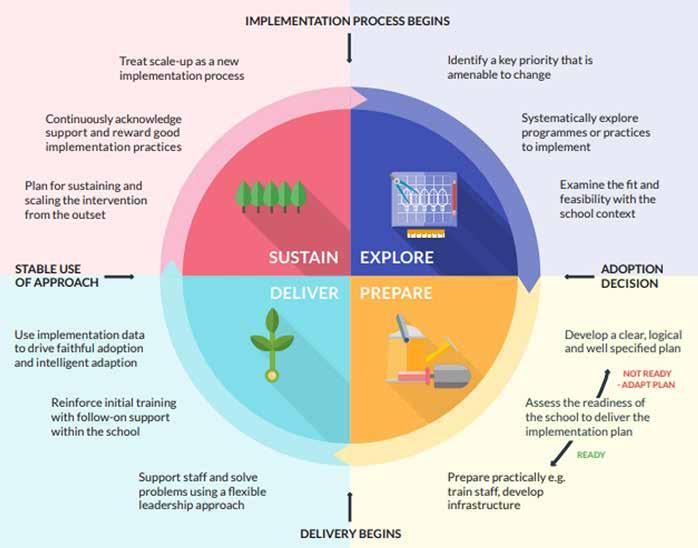
A potentially helpful lens to make these ideas more concrete is to consider what we do in the classroom. When thinking about our students, I think it’s fairly noncontroversial to say that we want students to understand the techniques we’re teaching them, not just regurgitate them. This will not only involve teaching students the underpinnings of a technique, going beyond the surface structures, but also giving them the knowledge about when they need to use a given technique i.e. what is the best technique based on the problem we are faced with. So, whilst it seems that Harpreet’s approach is a potentially common one, what could they take away by
looking though the same lens we just have? Firstly, they need to make sure they’re going beyond surface features and understand the key principles of the technique. Secondly, they need to ensure that the technique is aligned to a problem they’re trying to fix, helping make sure it’s fit for purpose.
Ensuring a deep understanding
“A shallow engagement can lead to inappropriate, and potentially even harmful, interpretations.”2
It’s fairly common to not understand a problem until we’ve already come across the solution – most of us don’t tend to go searching for problems, and often even if we do get a feeling of something not being quite right, we might just see that as the status quo. Let’s again consider this through
the lens of our students: it’s really unlikely that any of them ever saw not being able to solve equations as a problem until we pointed out that a) they need to solve it and b) showed them how to solve it. If we just stopped at step a) then we might end up in a situation where students see there’s a problem, but because they don’t know the solution they just accept the fact that a problem exists as status quo, as we might when we get the feeling that something’s not quite right. The Education Endowment Foundation (EEF) recognised this and put together A School’s Guide to Implementation – guidance designed specifically to help schools and school leaders identify, understand, and implement fit-for purpose solutions. A key part of the guidance is the implementation cycle:
JANUARY 2023 // HWRK MAGAZINE // 49 HWRK MAG AZINE .co. UK LEADERSHIP
(The EEF suggests there are two prerequisites for effective implementation based on culture and climate. As they are beyond the scope of what we’re discussing today, we won’t delve into them but it would’ve been remiss to not mention them.)
The start of this cycle involves 2 key ideas:
• Framing the solution around a problem
• Developing a deep understanding of potential solutions and their feasibility
Let’s return to Harpreet and understand more about how they decided to focus on spaced practice:
Last year Harpreet’s school placed a big focus on retrieval practice, with it becoming a regular part of many lessons. Over the summer, Harpreet came across several articles that showed how retrieval practice could be “boosted” by incorporating spaced practice. So rather than just having a practice quiz at the end of each week, by spacing out the learning students would benefit even more. One experiment3 that Harpreet read about put students into two groups: one group spent 30 minutes studying in one go, whilst the other spent 10 minutes over three consecutive days. They were given a test one week later and the
group who studied across 3 days did about 30-40% better! Harpreet immediately started thinking about how he’d help department leaders to restructure their schemes of work so that the learning could be more spread out.
The reasonings for Harpreet’s decision making here inherently make sense – who wouldn’t want their students to get 30-40% better?! But by focusing on the result, we’ve overlooked the mechanism the was used to achieve it. It’s like saying Lewis Hamilton wins races because his car is fast – whilst accurate it doesn’t tell us how he gets the best performance out of his car – how does we beat other people who also have similar cars? What would likely have helped Harpreet here is two things:
• Understanding the limitations of the conclusions that can be drawn from that experiment
• Focusing on the mechanisms that gave those results
The researchers for this experiment had the luxury of being able to spread that learning out over time, something teachers often don’t have. They also tested a really limited set of materials, again not something that teachers are likely to do. This isn’t to say
we should throw the baby out with the bathwater, but we need to think hard about how it might work in more realistic school settings, as that’s what we’re working in. The best way Harpreet could have done it? Focusing on the mechanisms. What was it specifically that resulted in that 30-40% difference? Was it the type of practice the students were doing? Was it the re-exposure? Was it both? Or something else altogether? The answers to these questions are critical when thinking about the feasibility of solutions for a particular context.
Starting with a problem
“If we’re all working, all the time, to try to solve really challenging problems, then feedback isn’t because you’re a bad teacher. Feedback is because you are a teacher.” 4

We can call the approach that Harpreet’s taken “action first” – Harpreet has found a technique that they feel will benefit students in their school and so is trying to put it into action. One of the issues is, by focusing on the action teachers aren’t able to focus on what “good” looks like. Taking an action first approach means our measure of success is simply doing the action without accounting for our goal of ensuring it’s having a positive impact on our students. So, what’s the alternative?
Taking a problem first approach means that teachers must look beyond doing the act and focus instead on student learning. It means our measure of success is, “is students’ learning better now?”. The answers to this question will allow us to easily decide if we should carry on, adapt, or stop the action we’re using.
We can also tie these ideas together: by focusing on the problem, we are helping teachers build their own understanding of what “good” looks like which will be specific to them and their classroom. By focusing on mechanisms, we’re also helping teachers understand what they can adapt to best meet the needs of their classroom and solve the problem they face! These two ideas go hand-in-hand and work together to help support teacher development and, most importantly, get improved outcomes for our students.
@hwrk_magazine 50 // HWRK MAGAZINE // JANUARY 2023
1Spaced practice (also known as distributed practice) is the technique of returning to key ideas over several, smaller episodes, rather than one or two bigger episodes (Gill, 2022).
2 EEF, (2021). Putting Evidence to Work: A School’s Guide to Implementation 3 Roediger, H. L., & Pyc, M. A. (2012). Inexpensive techniques to improve education: Applying cognitive psychology to enhance educational practice. Journal of Applied Research in Memory and Cognition, 1(4), 242-248. 4Sarah Cottingham, (2022). Professional development: from answers to problems. https://overpractised.wordpress.com/2022/06/05/professional-development-from-answers-to-problems/
Developing expertise through A CoAChing CurriCulum
Sam Gibbs explores what is meant by coaching, which can mean different things to different people, while offering suggestions on how to build an effective coaching curriculum to support teacher development.
By Sam Gibbs
It’s true to say there has been nothing short of an explosion of interest in instructional coaching in schools over the past few years. Certainly, the introduction of the Early Career Framework (ECF), which provides teachers in their induction period with a statutory entitlement to weekly coaching or mentoring, has contributed to this.


We have seen the production of a plethora of training programs, books, blogs and electronic platforms, all riding the wave of rising enthusiasm for instructional coaching. Many schools are keen to utilise its many benefits, to the point where it can sometimes seem like it is taking place in every school.
But of course, teacher coaching is nothing new – it has existed in schools for a very long time. Before rushing to jump on the current bandwagon, therefore, we need – like with any promising approach in education – to carefully consider the purpose and the implementation.

JANUARY 2023 // HWRK MAGAZINE // 53 HWRK MAG AZINE .co. UK LEADERSHIP
What is instructional coaching?
Whilst there are lots of different approaches and ‘flavours’ of coaching in the sector, instructional coaching (sometimes called pedagogic coaching) commonly has core ingredients, or ‘big ideas’ at its heart.
It involves an ‘expert’ working with a teacher in regular one-to-one sessions to gradually improve both their performance and their students’ learning. The expert could be an external coach, a senior leader, or an experienced teacher – and the coachee might be a novice or a more wellpracticed teacher.
This type of coaching is ongoing and circular: the expert regularly observes the coachee teaching, gives them feedback on what and how to improve, and helps them purposefully practise until they achieve their goals. Coaching can be more directive, or more dialogic, depending on the skills, knowledge and understanding of both coach and coachee.
Practice usually takes place outside the classroom in controlled conditions, using carefully chosen activities, before the teacher tries the strategy in class. By regularly revisiting and practising the same skills until goals are met, the learning process is optimised – it takes time, repetition, and support to overcome existing habits and create new, more effective ones.
What makes expert coaching?

When you observe an expert coach in action their expertise might look ‘natural’, but it is the cumulation of huge amounts of knowledge, skill and experience. A coach is a highly effective teacher, but that alone is no guarantee of being an effective coach: they must possess ‘conscious competence’, which is the ability to break down and share with others what makes them so effective in granular detail.
As well as being able to model highly effective practice, a coach must:
• understand teachers’ goals and motivation, • have a repertoire of techniques and be able to work out how to apply practices in the teacher’s contexts,
• be able to effectively diagnose practice, critique and provide useful feedback,
• manage the delicate balance of coaching individuals with whole-school improvement priorities,
• have skills of communication, change management, and leadership for teacher professional development (Knight, 2017), and build relationships based on trust (Finkelstein, 2016),
• use their expertise and relationships to guide a teacher’s development (Taylor, 2008).
This might seem a tall order, considering that most coaches are also busy teachers. So, we need to ask: how can schools better prepare and provide support for coaches?
@hwrk_magazine 54 // HWRK MAGAZINE // JANUARY 2023
How can we train great coaches?
Much of the current discussion about instructional coaching centres around the teacher and their development. But what about the coaches?
We might assume that being a highly effective teacher is enough preparation, yet many coaches are not actually experts, with all of the knowledge and skills they need to do the role well, and are not often well prepared to support the learning of other adults (Gallucci et.al., 2010). Often, coaches feel the role is ambiguous, poorly defined and lacking in support, yet schools entrust to them the development of their most valuable assets – their teachers. For this reason, Poglinco & Bach (2014) argue that coaches ‘should receive the most comprehensive training possible… [and] continue to participate in their own ongoing professional development as they lead the professional development of others in the school.’
LEADERSHIP
What this training should look like is less clear - there is a surprising lack of research which explains how individuals learn to be coaches and are supported to develop and refine their practice over time. How do they gain the skills they need to be effective? While some of the skills described above are tangible and ‘teachable’, what about the more tacit skills - how can we teach someone, for example, to build trusting relationships?
Clearly, learning to be an expert coach needs to go beyond being able to follow the steps of a pre-defined coaching model, and include all of the processes of learning, thinking and reflection. What, then, might school-based development for coaches look like?
A Coaching Curriculum
Instructional coaching both changes the context of a school and is changed by it (Hollweck & Lofthouse, 2021) and training for coaches should therefore be deeply rooted in the culture, climate, values and


improvement priorities of a school.
Implementing any initiative requires careful planning to ensure generic approaches are contextualised. The starting point for developing a training program should be, then, to consider its alignment with wider school learning. Utilising principles of curriculum design can be helpful here: in the same way that every lesson is part of students’ wider curriculum journey, coaching is similarly one part of the whole of a teacher’s professional learning journey. The same principle applies to the professional learning of coaches.
At the Greater Manchester Education Trust we are developing our ‘coaching curriculum’ to ensure all of our coaches have the knowledge and skills needed to be highly effective in their roles. This means investing in time for them to learn, practice, read and reflect, and to this end we provide an hour a week for their professional development, in addition to the timetabled slots they are given to coach teachers.
JANUARY 2023 // HWRK MAGAZINE // 55 HWRK MAG AZINE .co. UK
In designing our curriculum, we have focused on three key questions: what are the key concepts, domains of knowledge and skills we want to prioritise to develop their expertise; who are the staff members best placed to coach our teachers, both now and in the future; and how will we implement our program?
What
The starting point of any curriculum is defining what expertise looks like and identifying the content to be taught which will develop it over time. Professional learning for coaches will need to incorporate pedagogies, practices, research, techniques, principles of effective teacher development and selected coaching models. But like any curriculum, some knowledge is easy to codify and teach, while other aspects are more tacit.
We know that effective coaching is based on understanding teachers’ goals, building relationships and emotional intelligence, and so we can put key concepts of affirmation and critical friendship at the heart of a coaching curriculum, using them as organising principles to provide a golden thread across domains of knowledge and skill. We can also show what they look like in action in coaching relationships, and model them when coaching our coaches to improve.
In the early stages, coaches’ understanding can be supported and scaffolded – for example, you might provide a specific process for coaching, evidence packages of research, a content framework which codifies key pedagogies or a rubric for developing teacher expertise.
Who
As we have previously seen, coaches are not ready-made experts, and so identifying staff to take on the role in your context might mean challenging your assumptions and your first instinctive responses. Coaches must have the time and capacity for meaningful work with teachers, but of equal, if not more, importance are to have, or to be able to develop, emotional intelligence, empathy and the ability to build trust, as well as a willingness to continually develop their own practice as well as the teacher’s.
How
In part, the ‘how’ of training coaches involves the ‘nuts and bolts’ planning – time, capacity, remit. A key aspect of implementation planning is also considering training inputs: the modes and methods to be utilised, and the mechanisms to be included. For example, how much of the training should be direct input,
engaging with research, reflective practice or collaborative planning?
If coaching models are being implemented across a Trust or group of schools, there is a question of contextualisation and whether coaches should train in the same way in every school. There is evidence, for example, that some school contexts make it more challenging for coaches to learn, particularly if there are several new practices being taught simultaneously, as cognitive load may be higher (Gallucci et.al., 2010).
However the content of the training is organised, and through whichever mechanisms it is delivered, a coaching curriculum needs to operate within a culture and climate conducive to the professional development of coaches. It must be meaningful for the context, building the knowledge, skills and conceptual understanding coaches need to be effective and to continue improving over time. And like any curriculum, it must be responsive, adapting its content and mechanisms as coaches continuously develop their practice.
final Thoughts
Instructional coaching is neither a silver bullet for school improvement nor a panacea for all problems, and so before rushing to jump on the bandwagon, it’s important to take time to reflect on the purpose it may serve in your context. Adoption without consideration of the complexities is unlikely to yield the results we seek.


Placing the coaches themselves at the heart of these considerations and committing to their learning and development is crucial: if we believe it’s important to invest in our teachers – and we should – we need to invest first in the people who develop and support them.
sam Gibbs
Trust Lead for Curriculum and Development
The Greater Manchester Education Trust
RefeRenCes:
Finkelstein C. (2016). Thank you so much for the truth! Phi Delta Kappan. 2016;97(7), p.19-24. Gallucci, C. et. al. (2010). Instructional Coaching: Building Theory About the Role and Organizational Support for Professional Learning in American Educational Research Journal, December 2010, Vol 47, No.4, p. 919-963.
Hollweck, T & Lofthouse, R. (2021). Contextual coaching: levering and leading school improvement through collaborative professionalism. International Journal of Mentoring and Coaching in Education, volume 10, No. 4, 2021, p. 399-417.
Poglinco, S. & Bach, A. (2014). The Heart of the Matter: Coaching as a Vehicle for Professional Development. Phi Delta Kappan. 2004;85(5), p.398-400. Taylor, J. E. (2008). Instructional coaching: The state of the art. In M. M. Mangin & S. R. Stoelinga (Eds.) Effective Teacher Leadership: Using research to inform and reform. p. 10-35. New York: Teachers College Press.
@hwrk_magazine 56 // HWRK MAGAZINE // JANUARY 2023
60. Are Teacher Side Hustles The New Normal?

More and more teachers are taking on “side hustles” to make ends meet. But is it sustainable?

hwrkMAG A zine.co.uk JA nu A r Y 2023 // hwrk MAGA zine // 59
Are Side HuStleS For teAcHerS tHe New NormAl?

More and more teachers are taking on “side hustles” to make ends
By Sherish Osman
Imagine working 5 days a week, getting into work around 7.30/8am, and leaving at 5pm, only to go home and do an hour or two of private tutoring, before getting on with your house chores, plus any extra marking or planning you didn’t manage to complete while you were at school. And then, when the weekend finally arrives, spending a few more hours either doing more tutoring, or working at the local cafe or bar. That is the reality of some teachers in 2022.
As the cost of living continues to rise, many teachers are finding that their salaries are not enough to meet their basic needs. And as a result, many educators are being forced to take on additional jobs in order to make ends meet and live a comfortable life.
The high cost of housing is a major factor contributing to the financial struggles of teachers. In many cities and towns across the country, the price of rent or a mortgage consumes a significant portion of a teacher’s salary, leaving little room for other necessities such as groceries, bills, or the cost of childcare.
Many teachers also struggle with student loan debt, adding an additional burden to their finances and making it even harder to make ends meet.
Financial struggle has a negative impact on teachers’ ability to focus on their work and to provide the best education possible for their students. When teachers are constantly worried about how they will pay their bills or provide for their families, it can be difficult to fully engage in their work and give their students the attention they deserve.
Teachers, struggling to make ends meet are now being forced to take on additional jobs, or “side hustles”, in order to provide for themselves and their families. This is both physically and emotionally draining, and it can be difficult for teachers to balance the demands of multiple jobs. It also means sacrificing yet more precious time with their own families.
I recently put out a tweet asking teachers what they did to earn extra income. Almost 50 teachers replied saying that they had one or two jobs on top of teaching;
which is a cause for concern. One commented that it was “appalling” that we even have to do this, but that is the reality for us now.
So, what are these teachers doing to earn an extra income? How are they managing it? Is it really as bad as it sounds? And is there any other benefit apart from the financial aspect?
Most of the responses to the tweet commented to say that they offered private tutoring, which is the most likely and most doable job for teachers, who already possess the skills required for this job.
If this is an avenue you’d like to try, then the hardest part is finding tutees. A lot of work can come in through word of mouth, but some work can come through offering your services via social media, targeting your local area. There are also websites that you can sign up to which allow parents to search for relevant and local tutors. Depending on circumstances, it can be quite easy to either go to the student’s house, or have the student come to you.
@hwrk_magazine 60 // HWRK MAGAZINE // JANUARY 2023 EXPERIENCE
meet. But is it sustainable?
I used to tutor privately for many years before I had my second child. I would work full-time during the week, then tutor four hours on a Saturday and four hours on a Sunday. This additional income helped massively in the running of a house.
Due to having my second child and struggling to balance things, and then Covid hitting us, I took a break for a couple of years. All was ok, until this year, as the cost of living has gone up dramatically, that I find myself looking for tutees again. It won’t be easy, but to ensure that my family and I live a comfortable life, it has become a necessity.
So yes, although it is feasible to do, it is time consuming: looking for tutees, planning and delivering sessions, speaking and feeding back to parents about said tutees.
Next on the list of side hustles for teachers was writing articles and books. This is something that can be done at your own pace and in your own time, so it is actually quite nice if you’re able to secure something that will pay you to write. Lots
of education magazines and websites take pitches from current teachers, and offer a small payment if your article is published.
Other side hustles for teachers include exam marking, childminding and babysitting, fitness instructors, working in cafes or restaurants, and some teachers run their own small businesses selling things they created themselves.
It’s important to remember that having a side hustle often means that you always feel you are against the clock, ensuring each job is complete, before rushing off to the next one. It also means that we need to be on top of our teaching workload to make it work. I ensure that any free periods I have at school are utilised, not wasted, so I get as much planning and marking done as possible.
What was more interesting though, was that as much as it is the recent cost of living crisis that pushes some of us to take on a side hustle, some have been doing it for a while. This only confirms that a teaching salary is not enough to
live a comfortable life, and hasn’t been for a long time.
I spoke to I-tasha Honeghan, an Assistant Head of Year, about what she does to bring in extra income. She said that she had always enjoyed working out, and going to fitness classes as it helped de-stress, and provided a sense of escapism from a busy teaching day. When she realised that she needed extra income, she looked into a course to become a fitness instructor. “I wanted other people to feel how I felt and needed to earn extra money. I looked into tutoring but it never really interested me. I looked into a few courses got some advice and decided to do my ETM (Exercise To Music) which was £400 and took 6 weeks to complete then my Les Mills Body Combat qualification, and passed.
I now have four classes a week, each 45 minutes long, on two evenings and two mornings at the weekend. I also cover instructors who can’t do their own classes. I earn an extra £400 a month and it fits around working in a school and my children, plus it helps with my fitness and mental wellbeing so it’s a win for me!”
JANUARY 2023 // HWRK MAGAZINE // 61 HWRK MAG AZINE .co. UK
For I-tasha, her side hustle kills two birds with one stone: not only is she making extra money to run the house, but it also provides her with much needed exercise for her wellbeing. It also allows her to build a community outside of school which she may not have had otherwise.
For myself, although I sacrifice precious family time to tutor on the weekends, it
has definitely made me a better teacher as I hone my exam skills.
The cost of living crisis facing teachers is a complex issue that requires a multifaceted solution. It is important for policymakers, schools, and the broader community to recognise and address the challenges that teachers face and work to create a more sustainable and supportive environment for educators.
But for those of us who can manage the workload (this is very important!) and can have time to work a side hustle, then there are ways to earn extra cash.
However, it isn’t always sustainable for long periods of time, with our teaching workload already being unmanageable, and it means we have to be very strict with the time we do have, so that we do not allow ourselves to burn to the ground.
@hwrk_magazine 62 // HWRK MAGAZINE // JANUARY 2023
EXPERIENCE




























 By Tabitha McIntosh
By Tabitha McIntosh














 By Jennifer Webb
By Jennifer Webb








 By Andrew Atherton
By Andrew Atherton


 By Louisa Smith
By Louisa Smith

















 By Amarbeer Singh Gill
By Amarbeer Singh Gill









